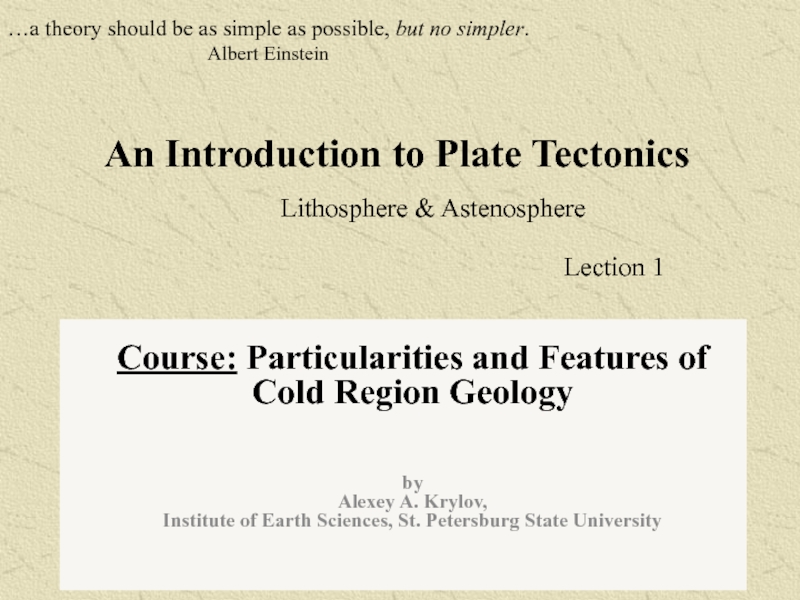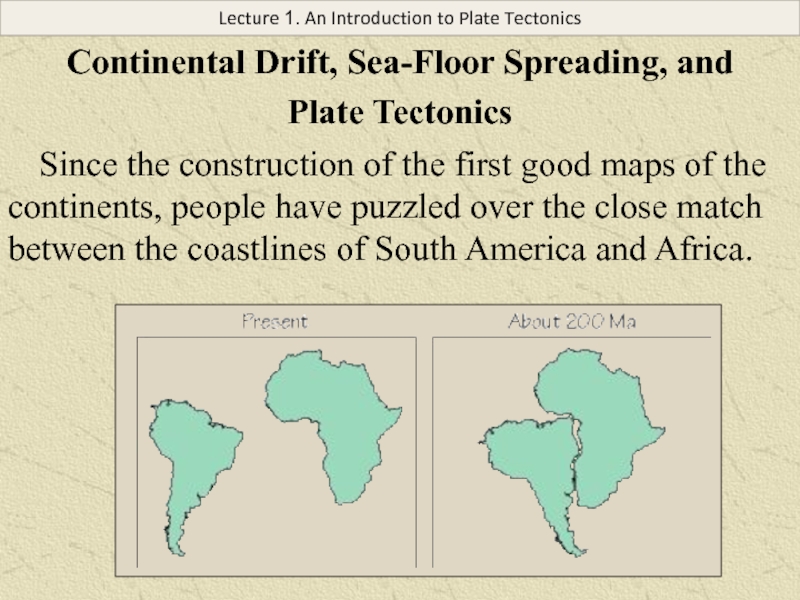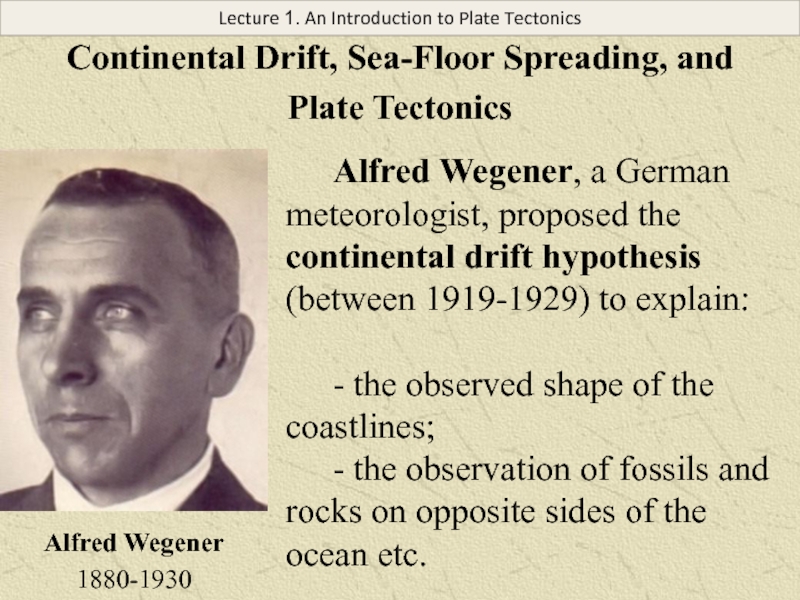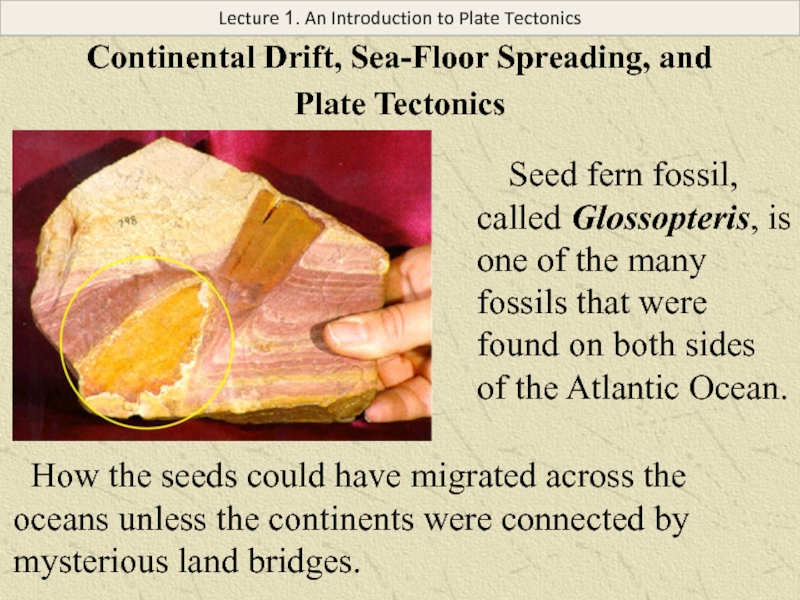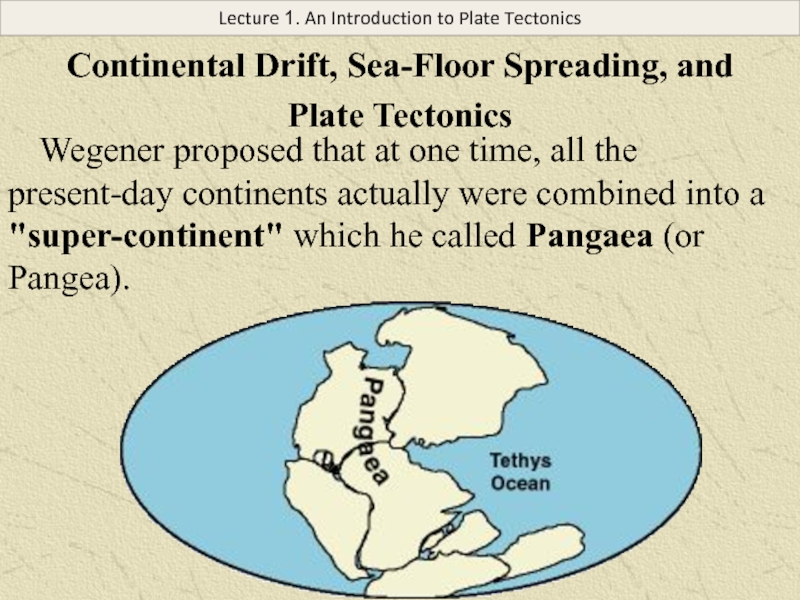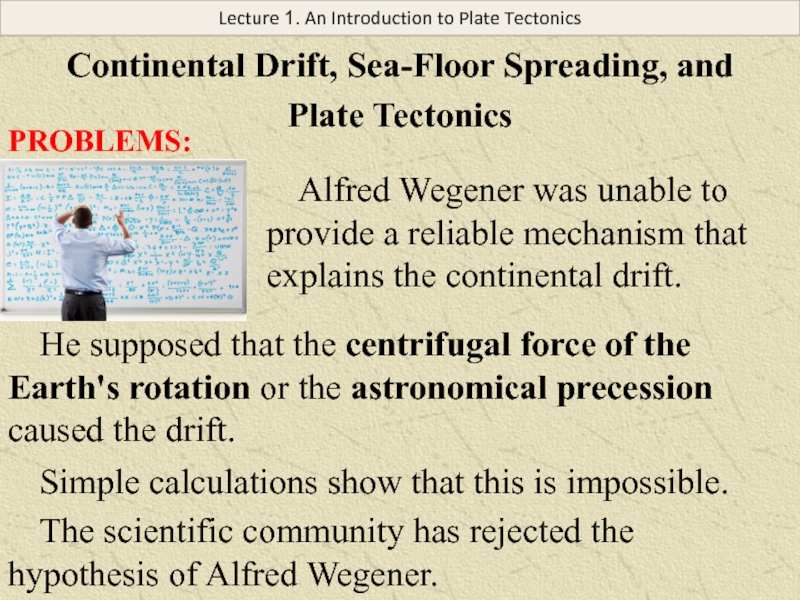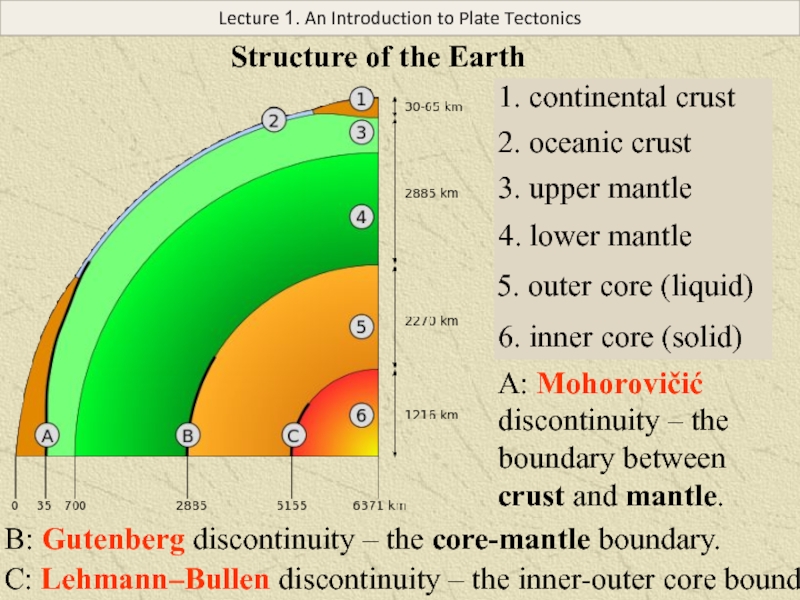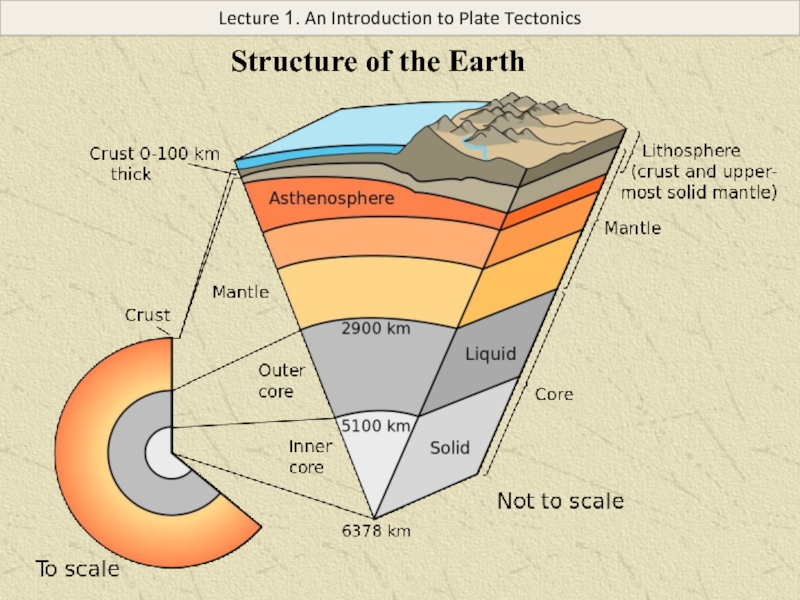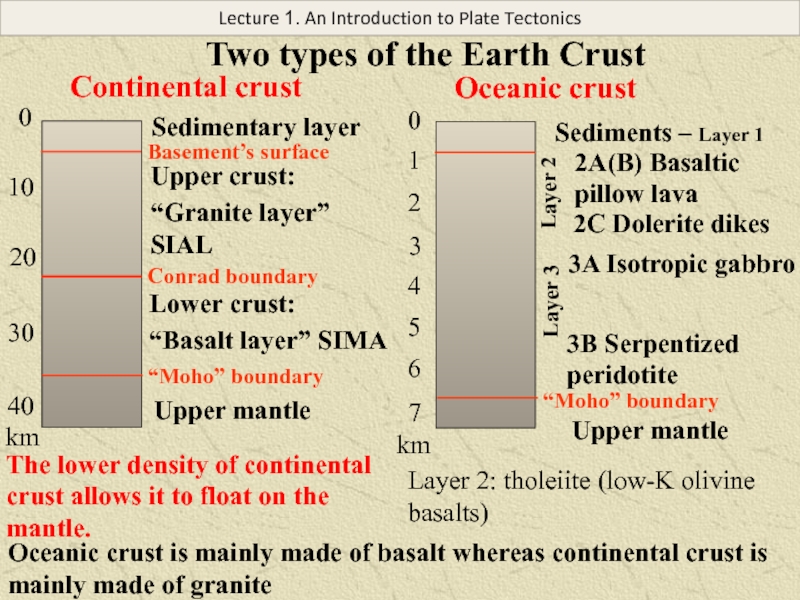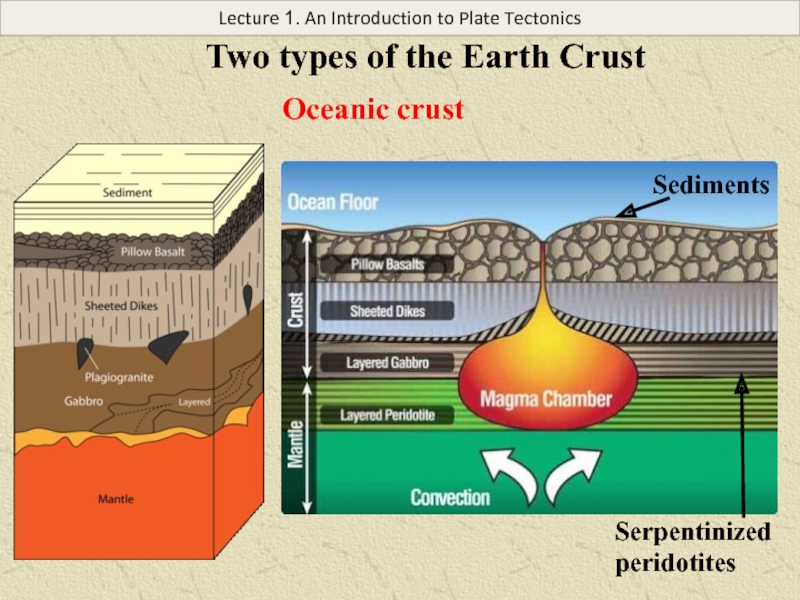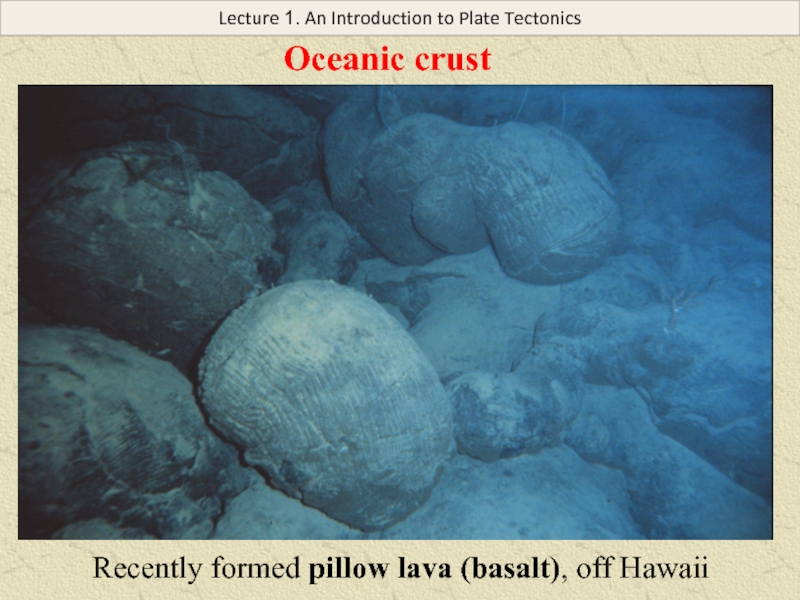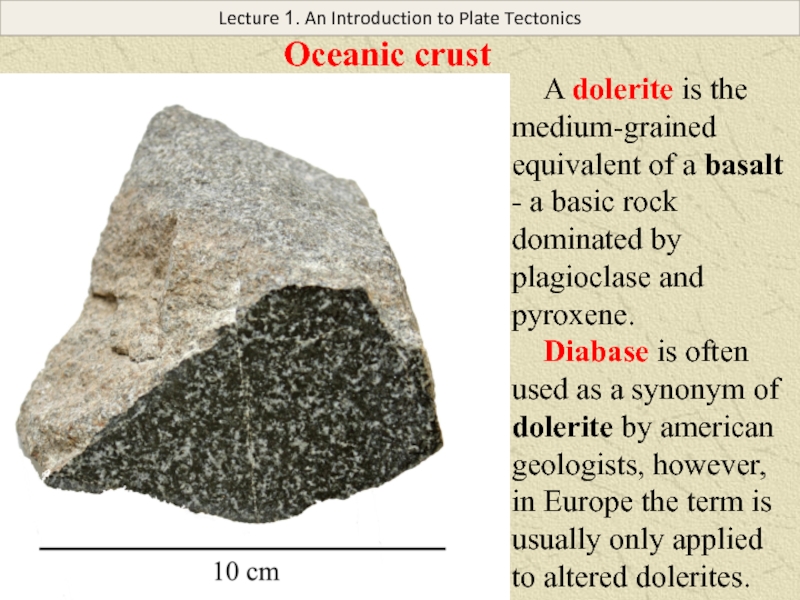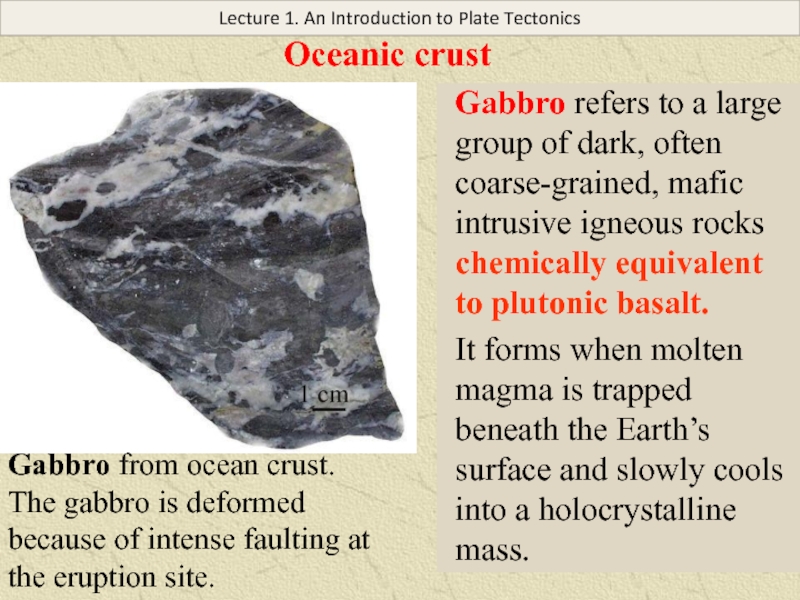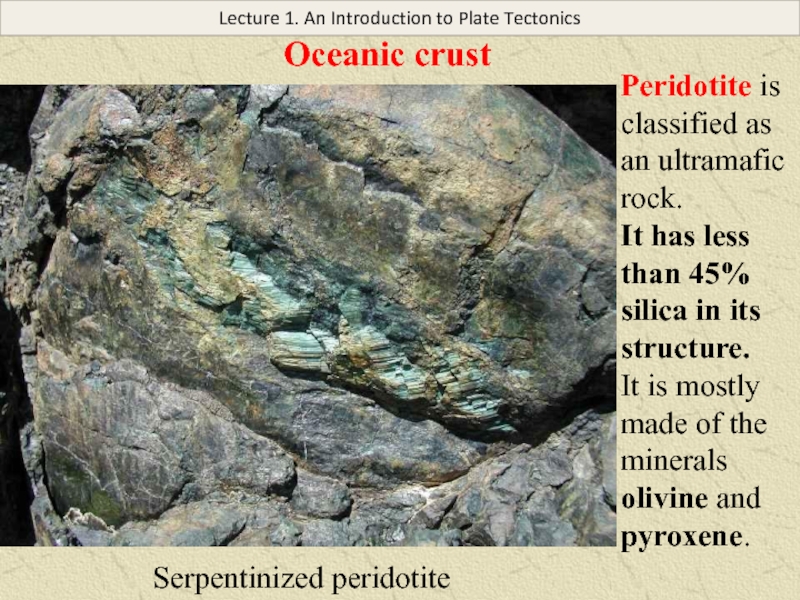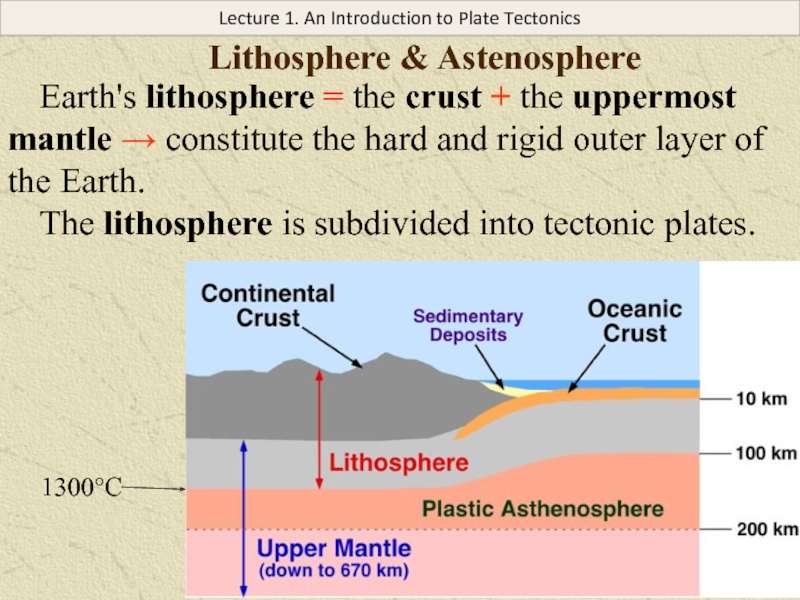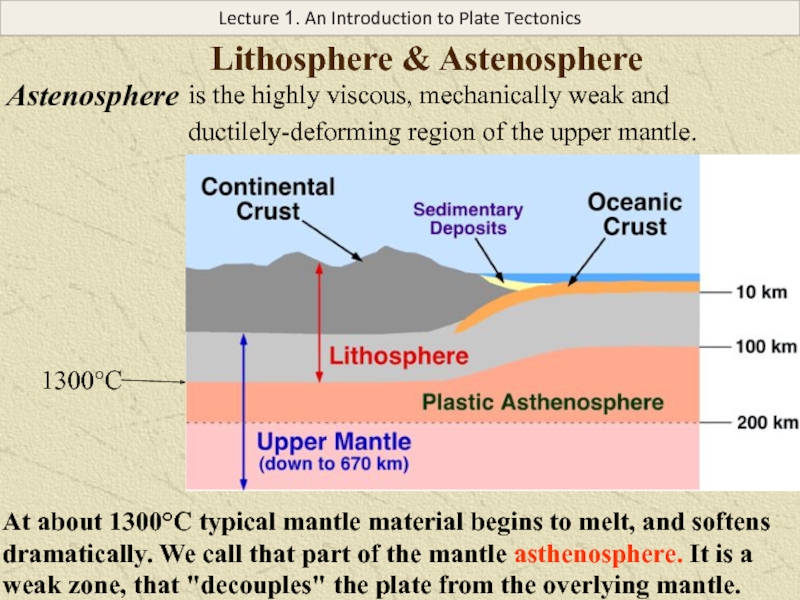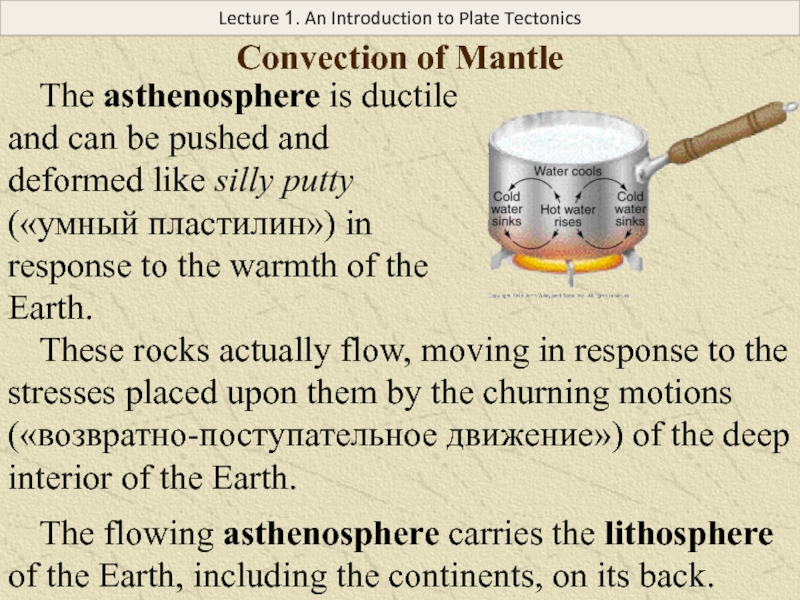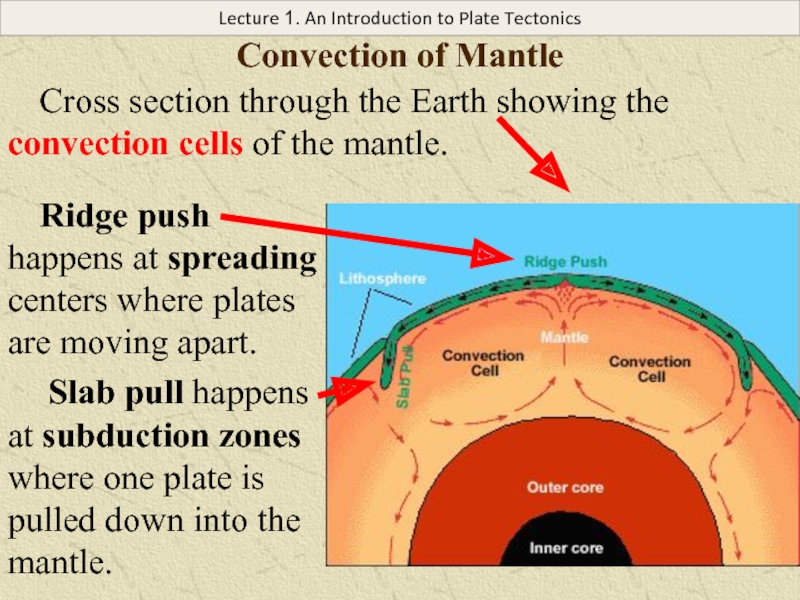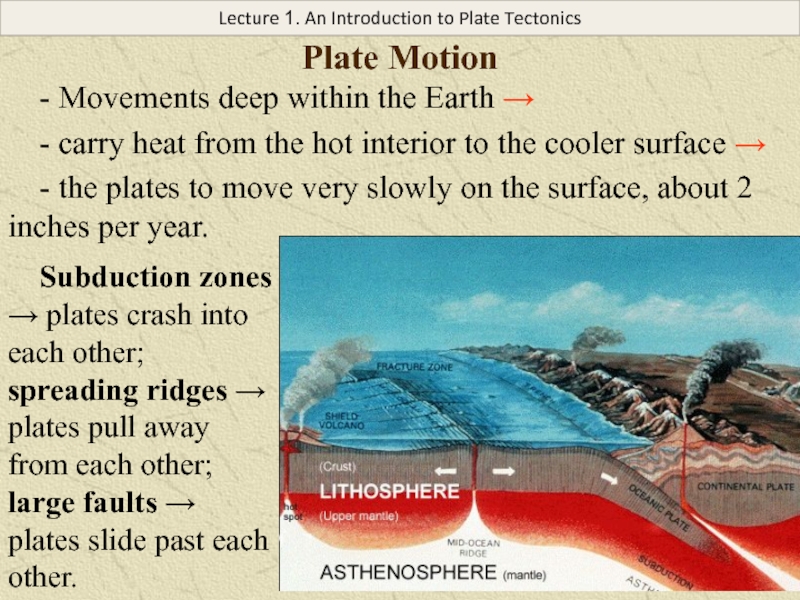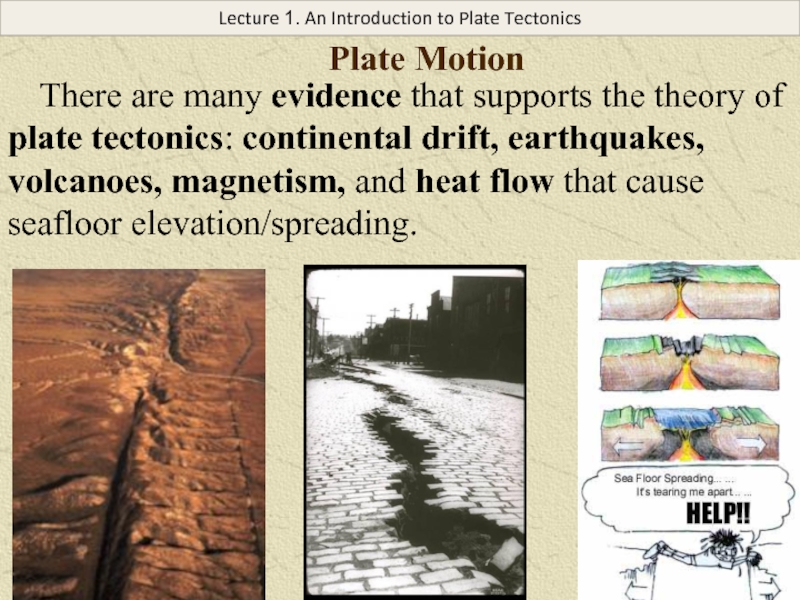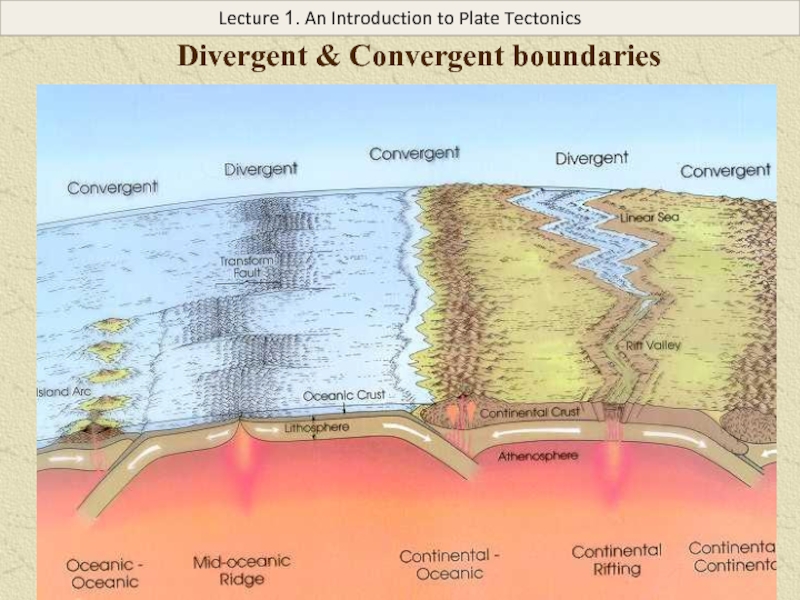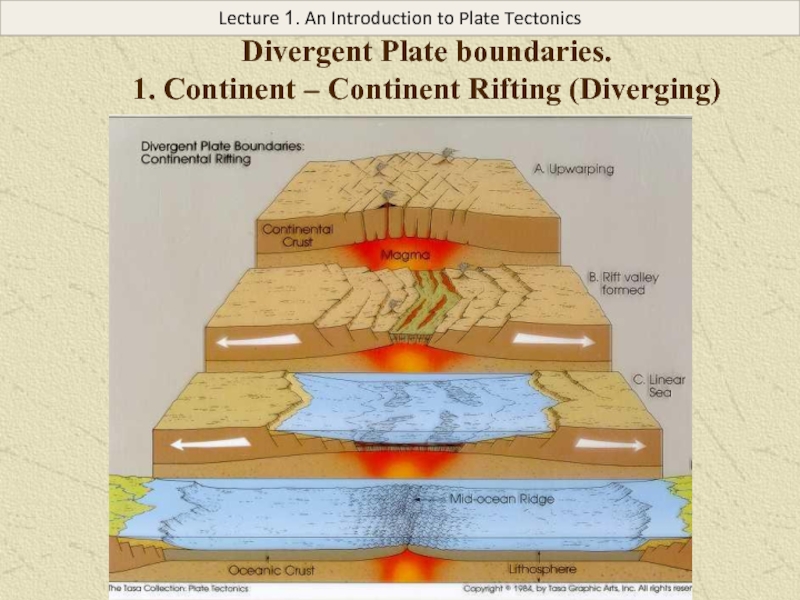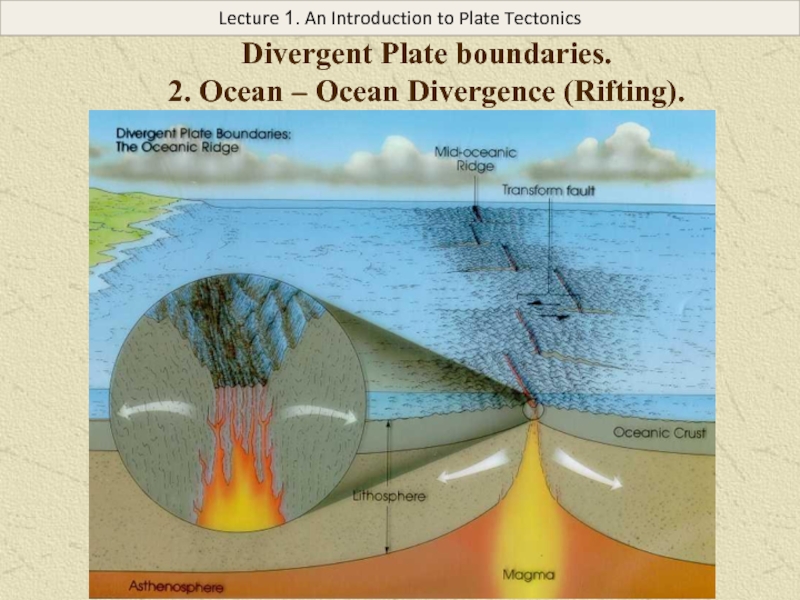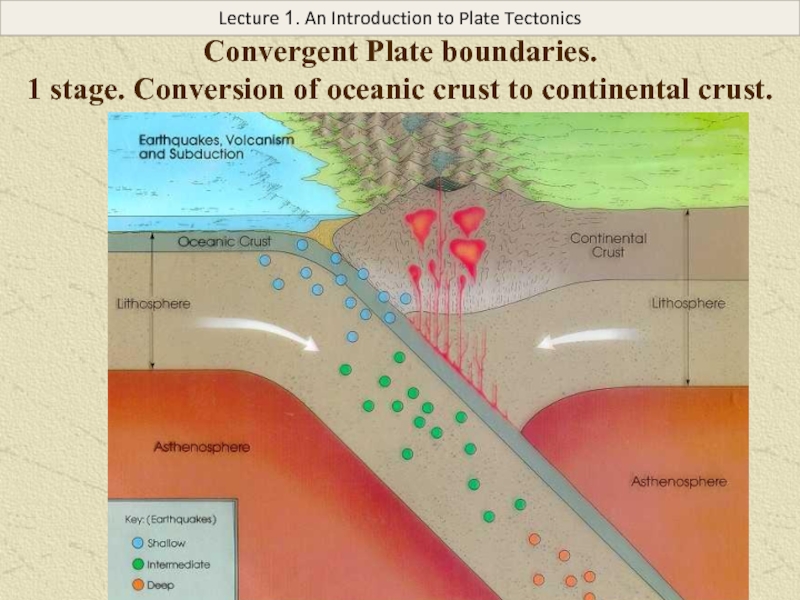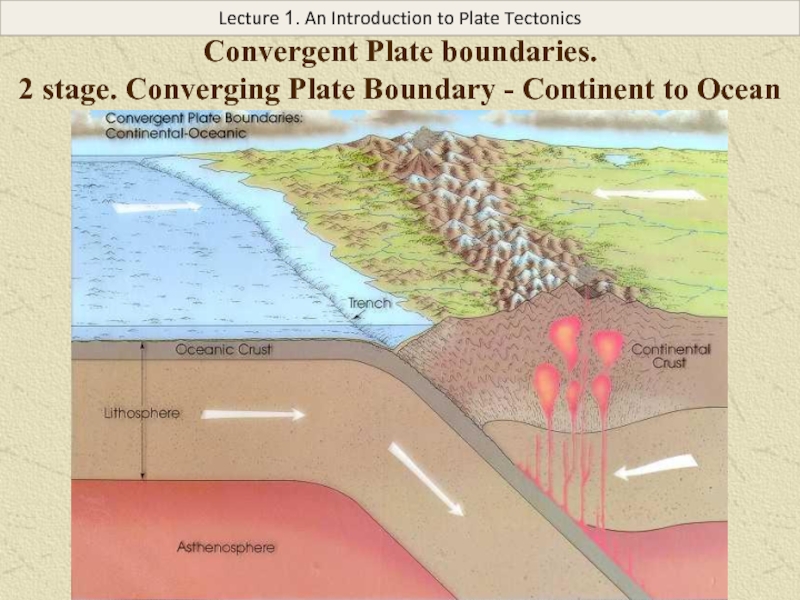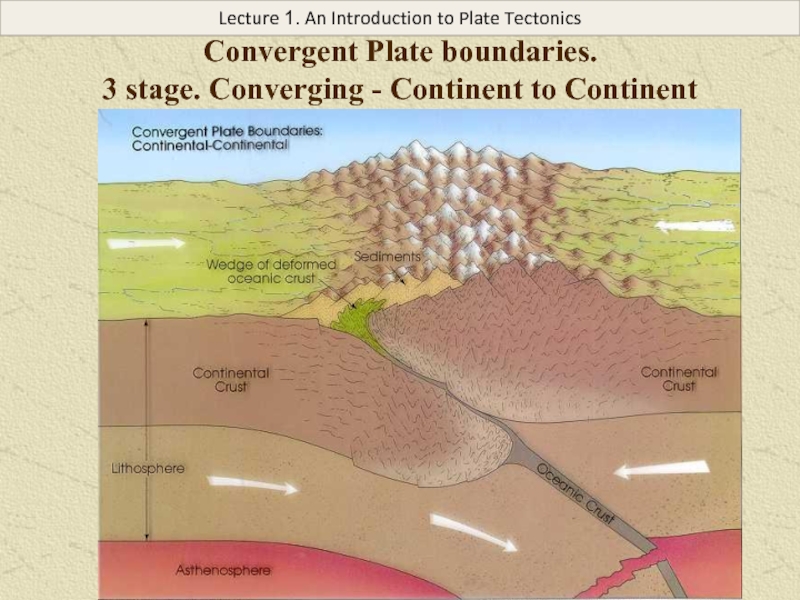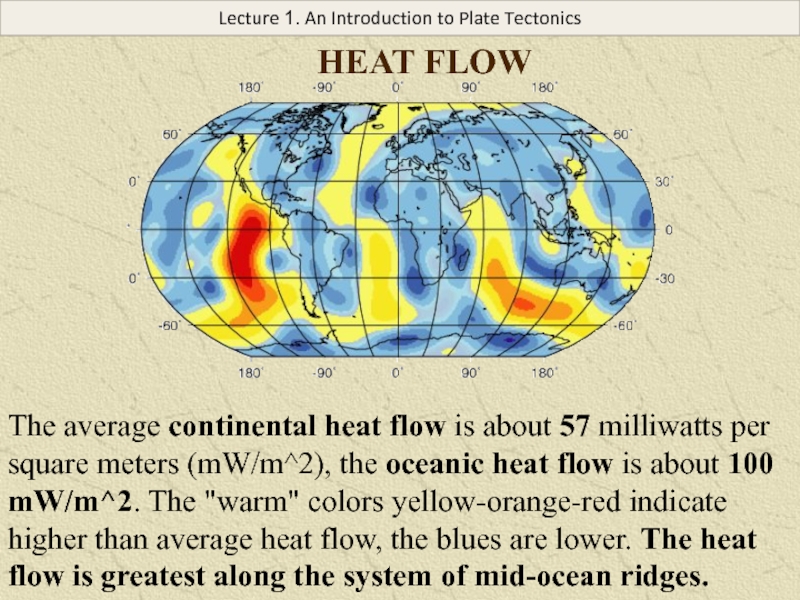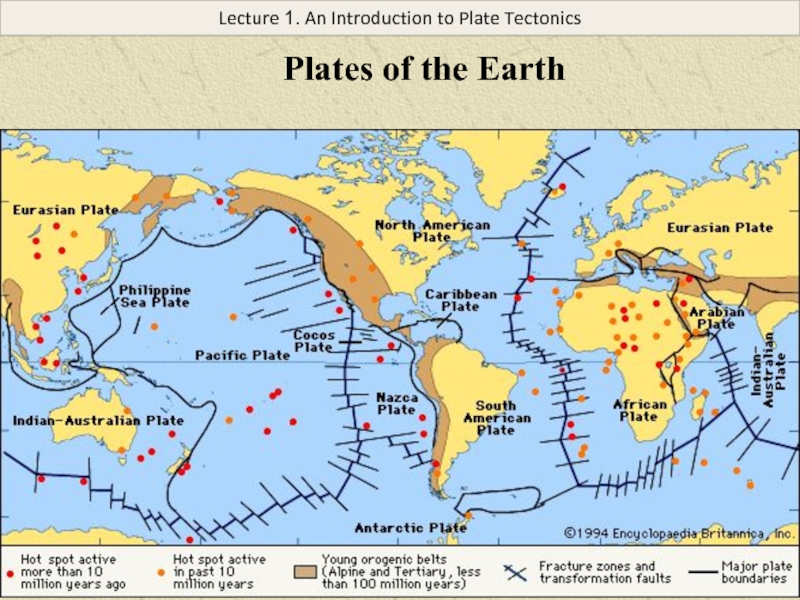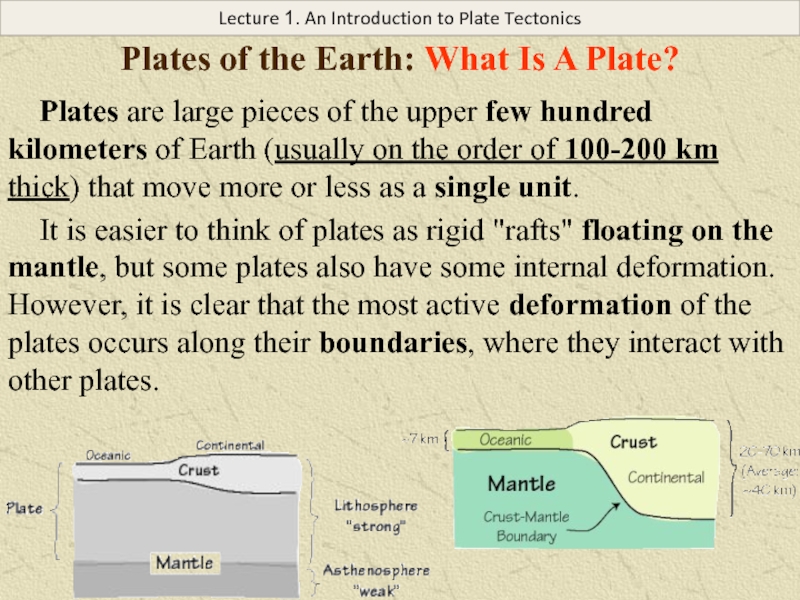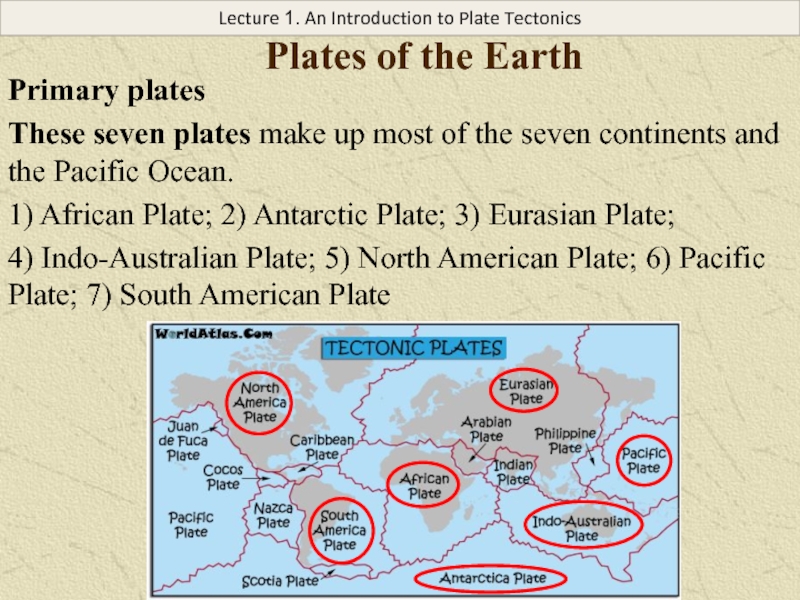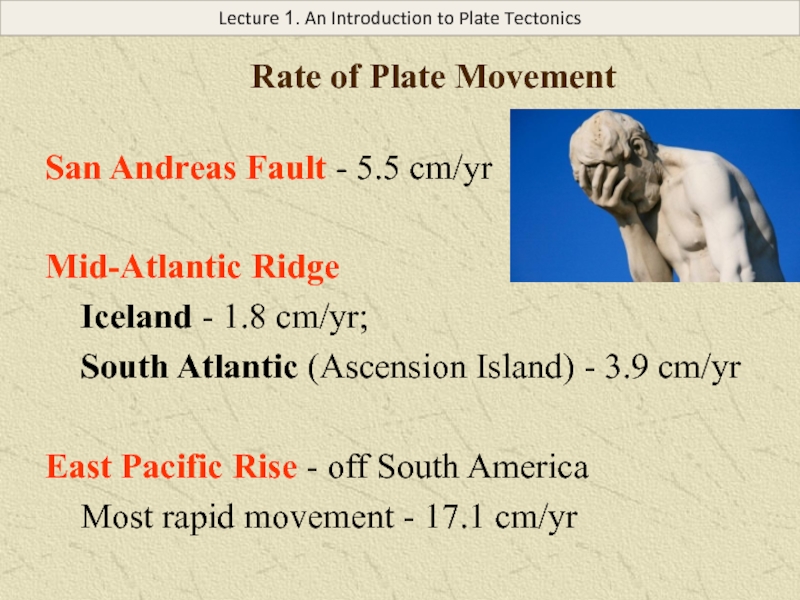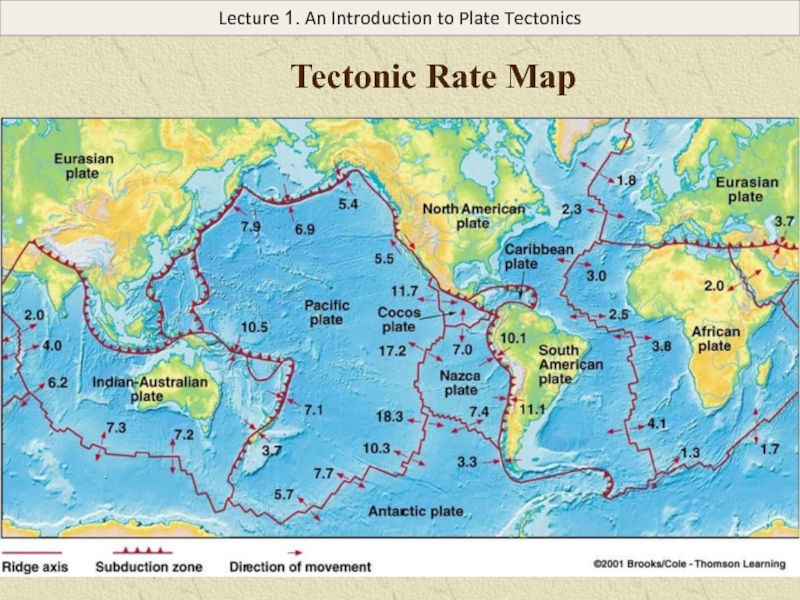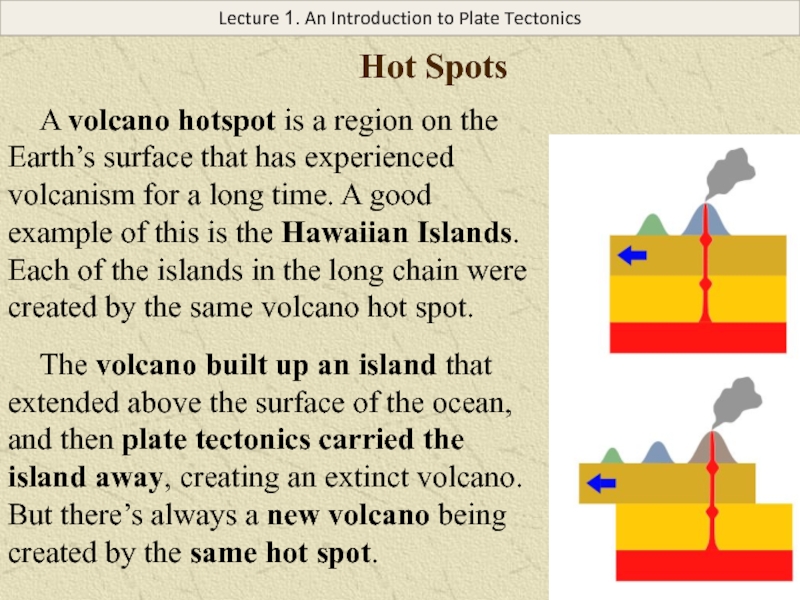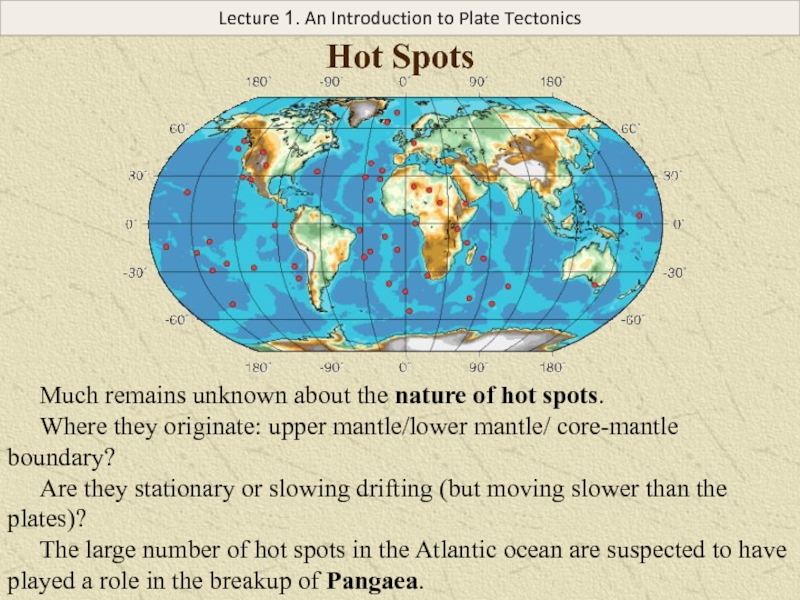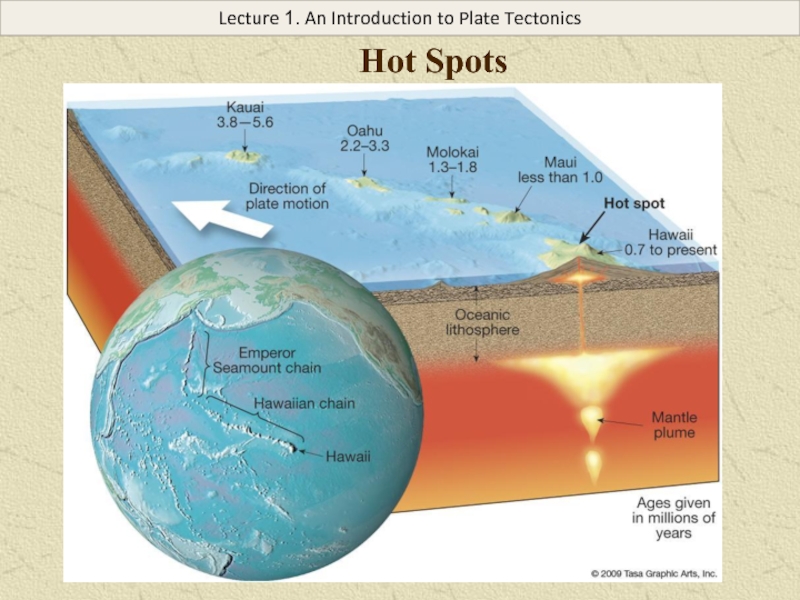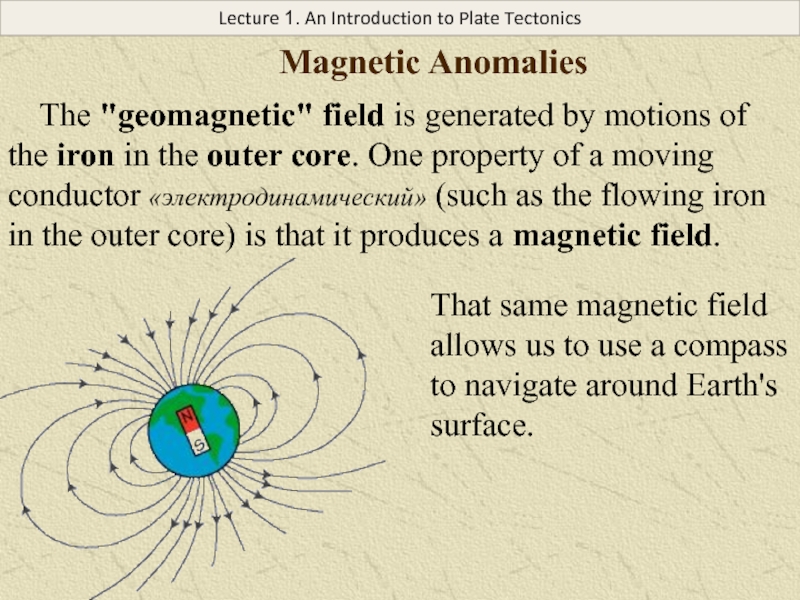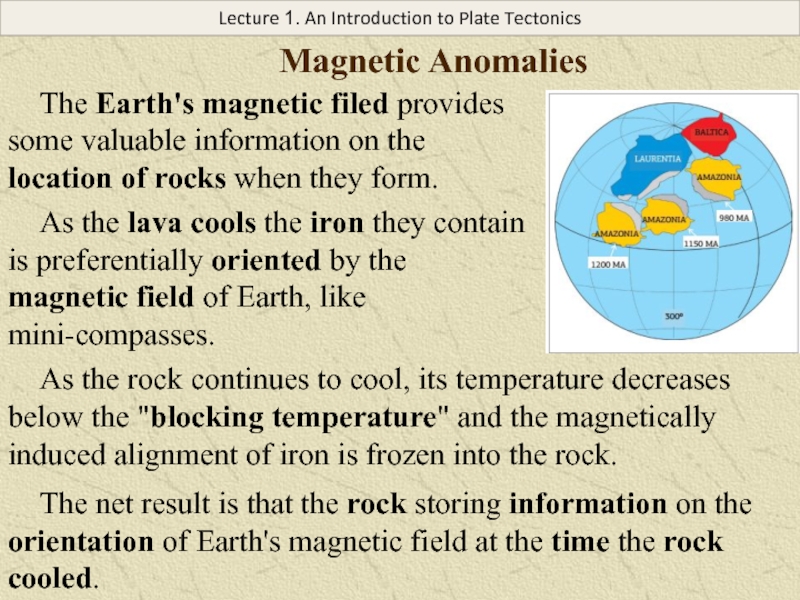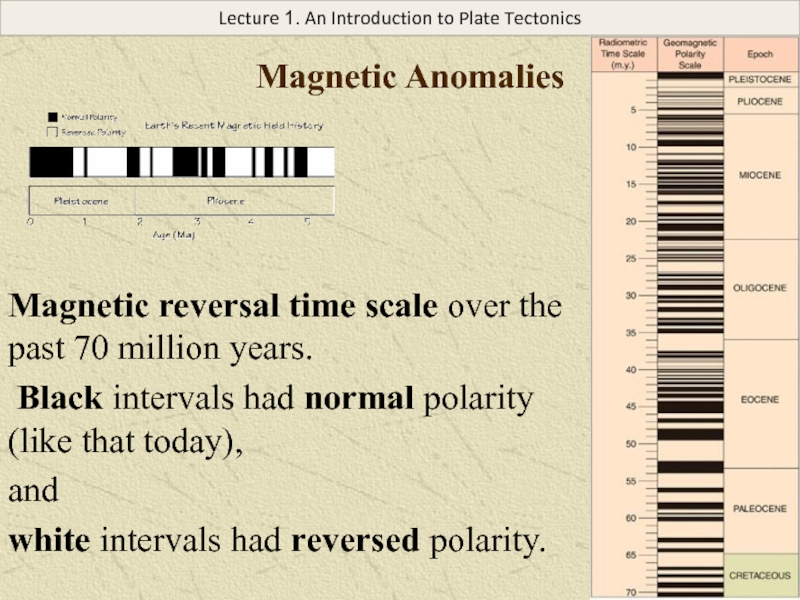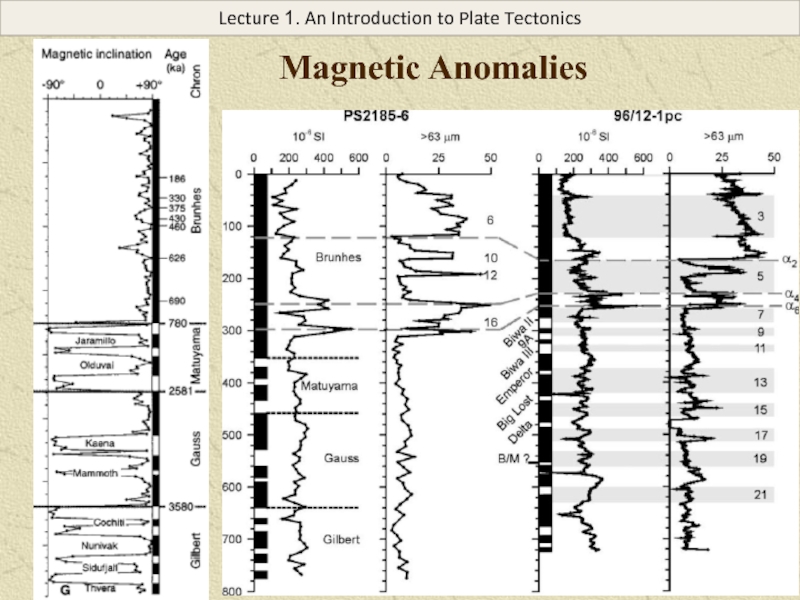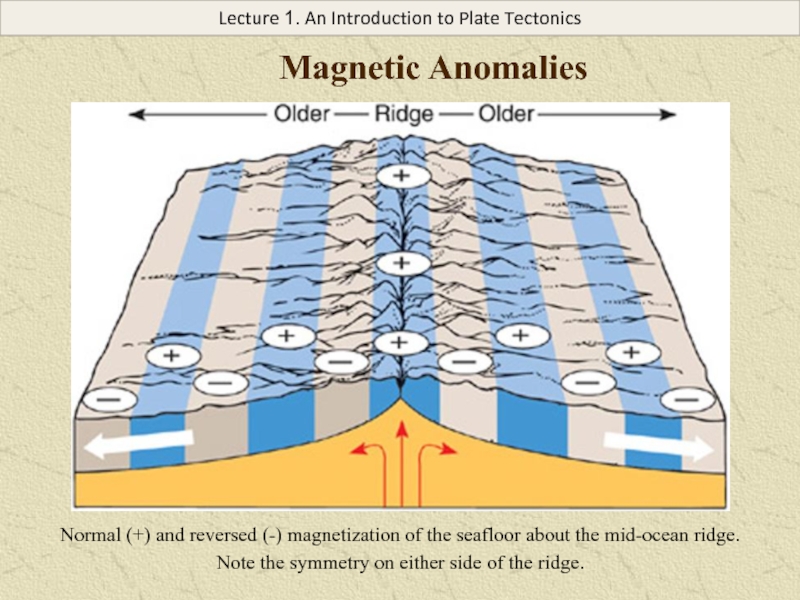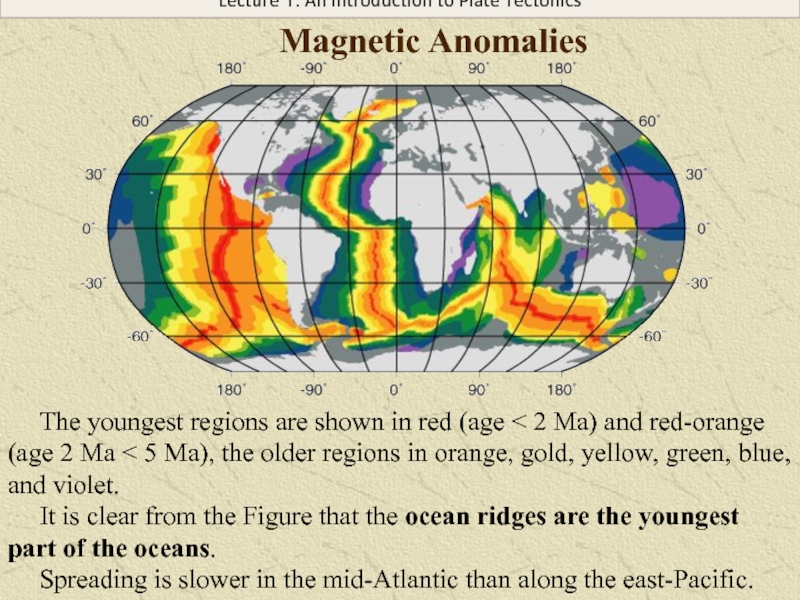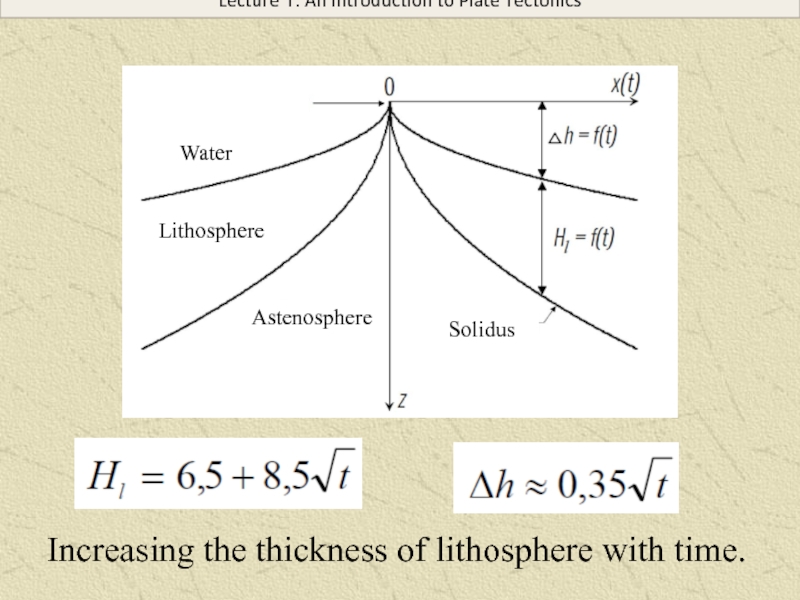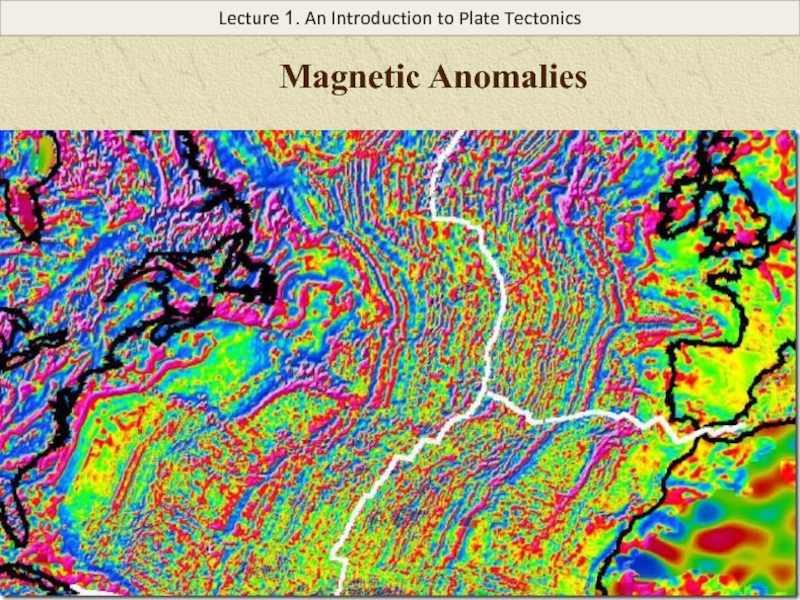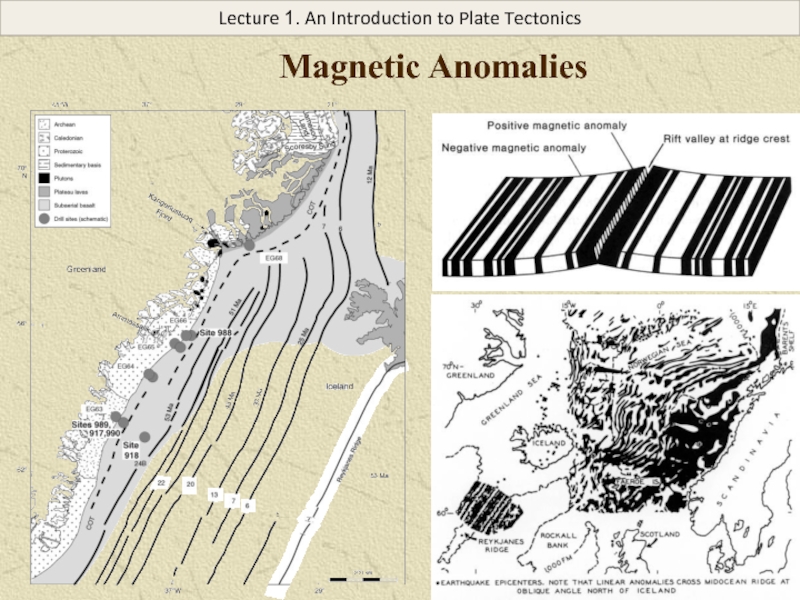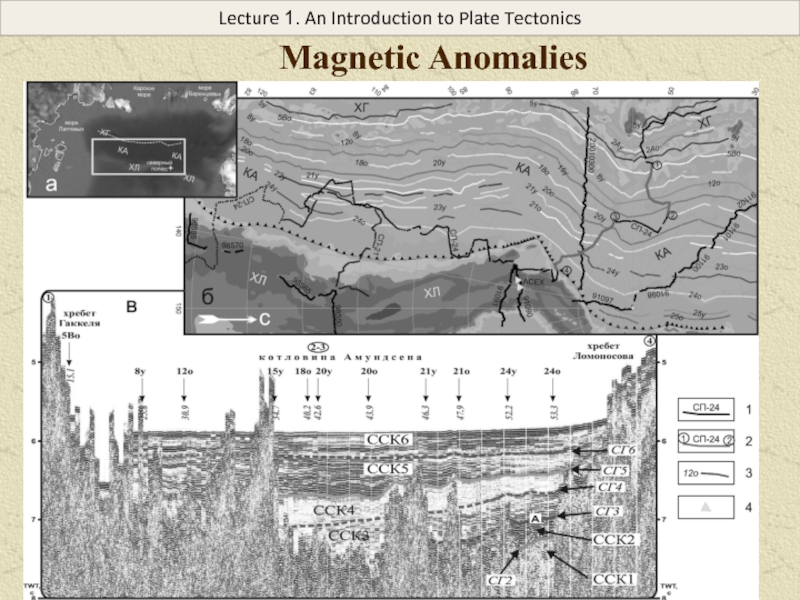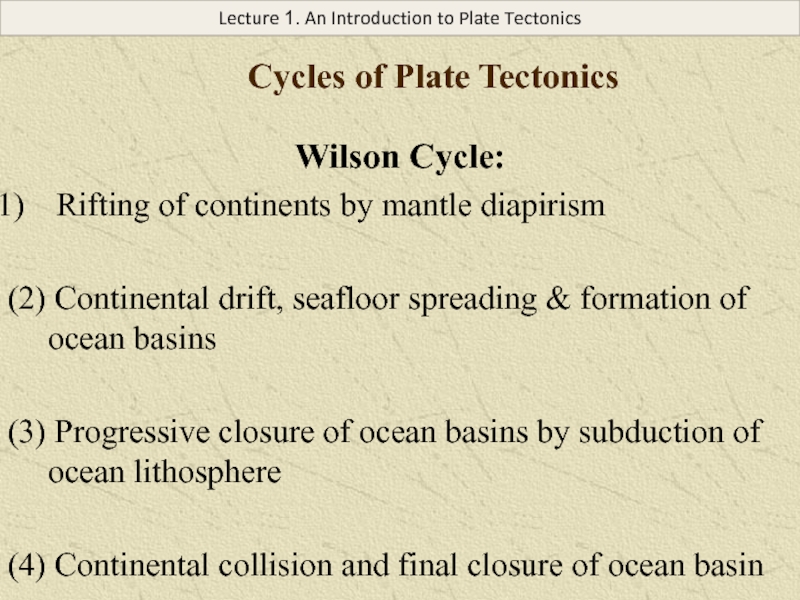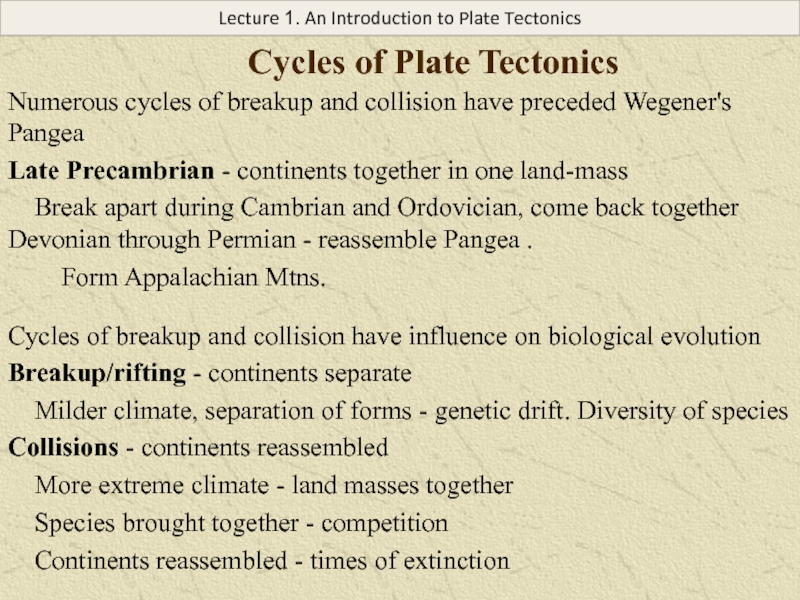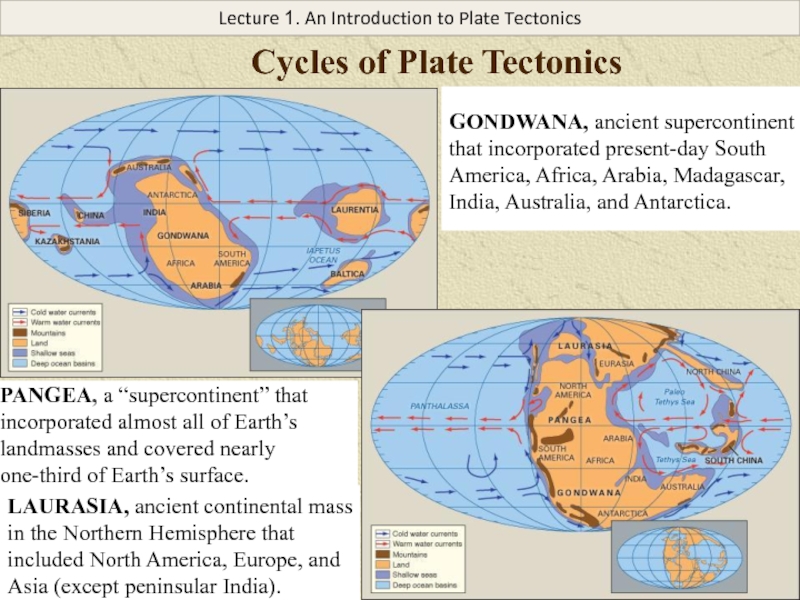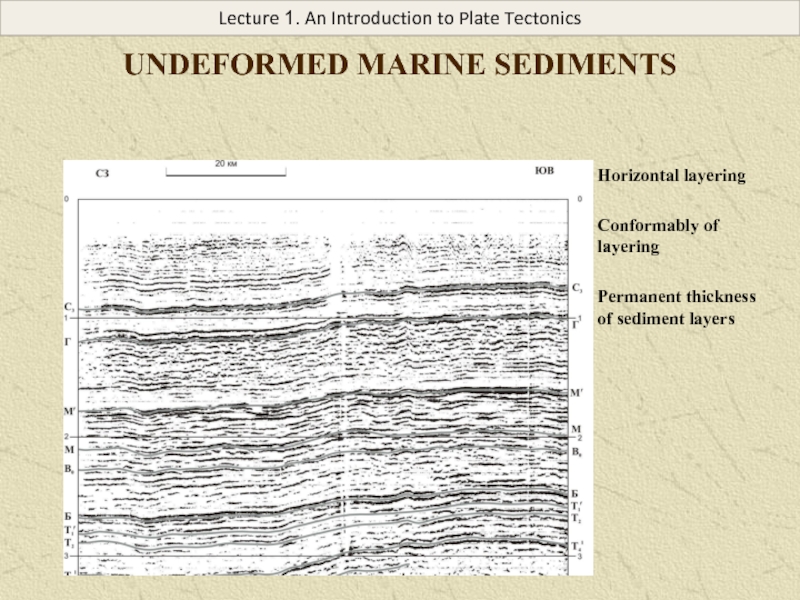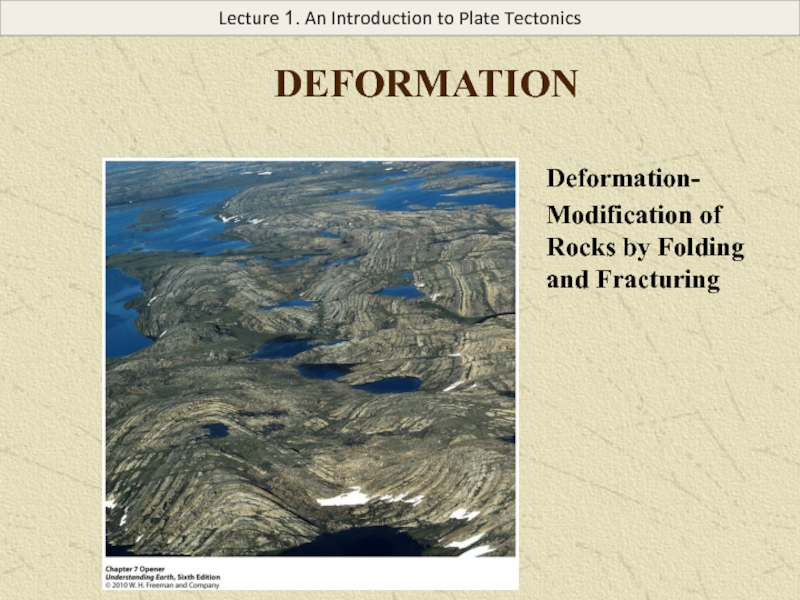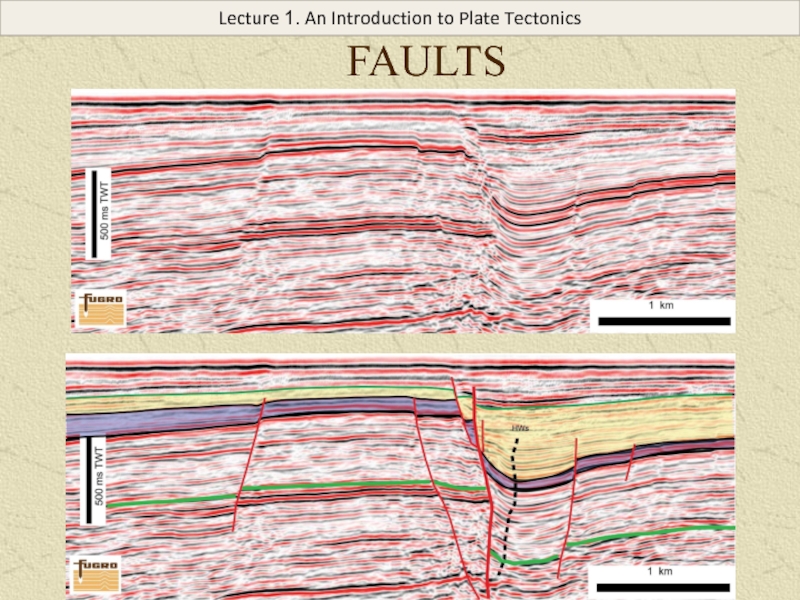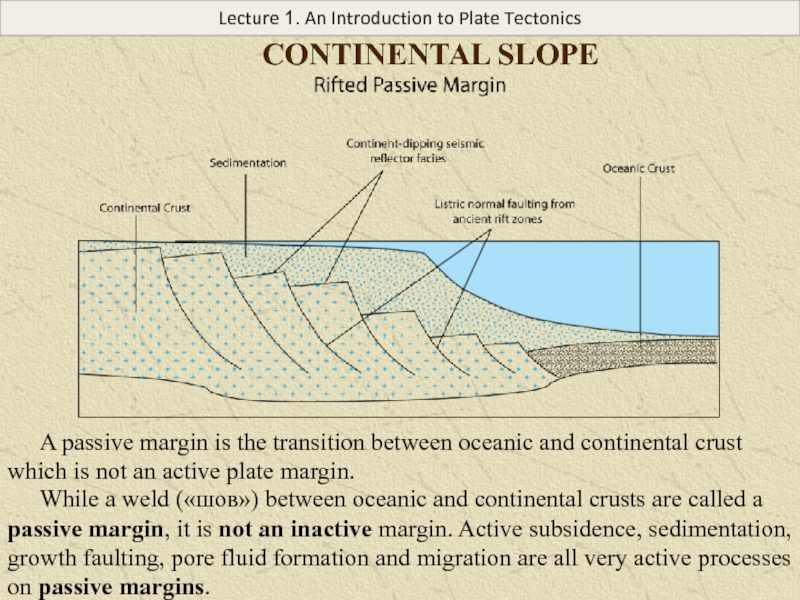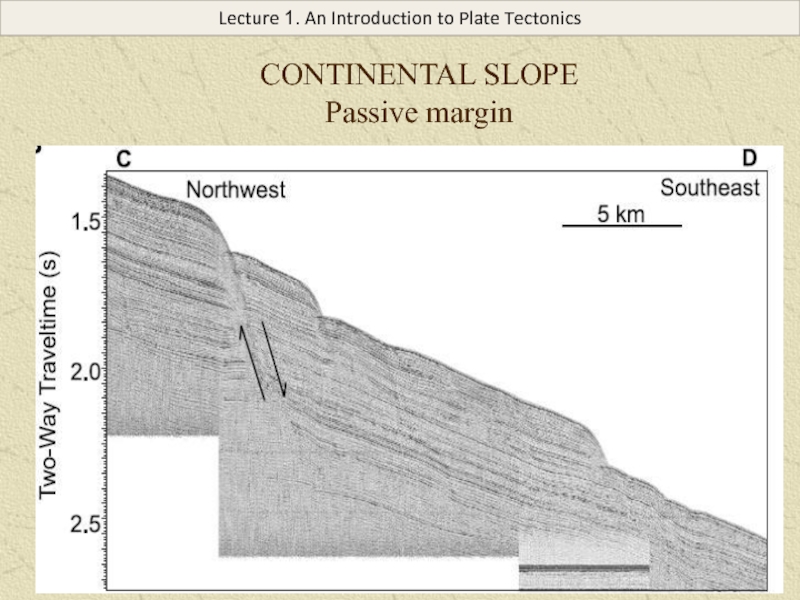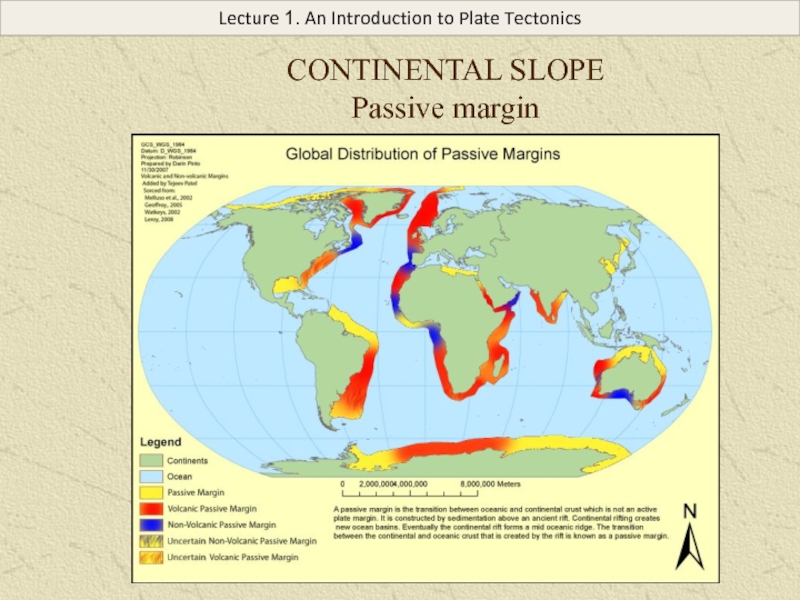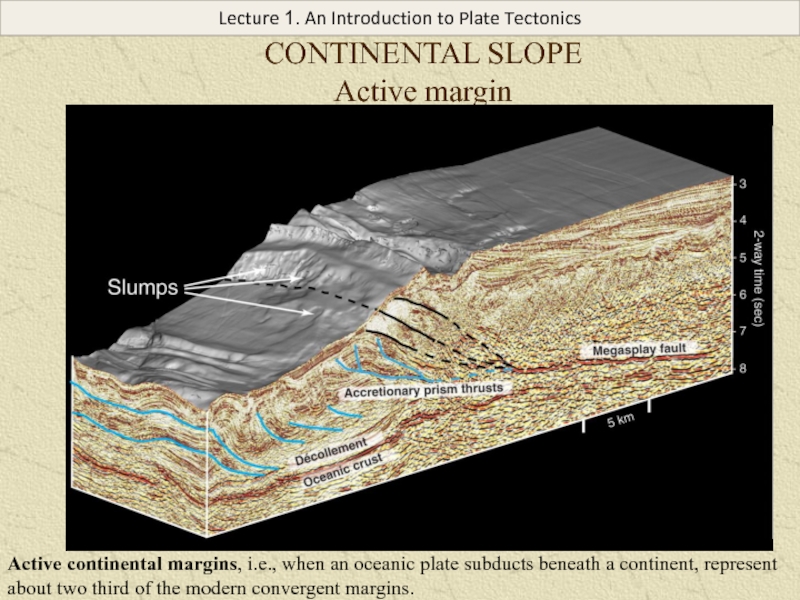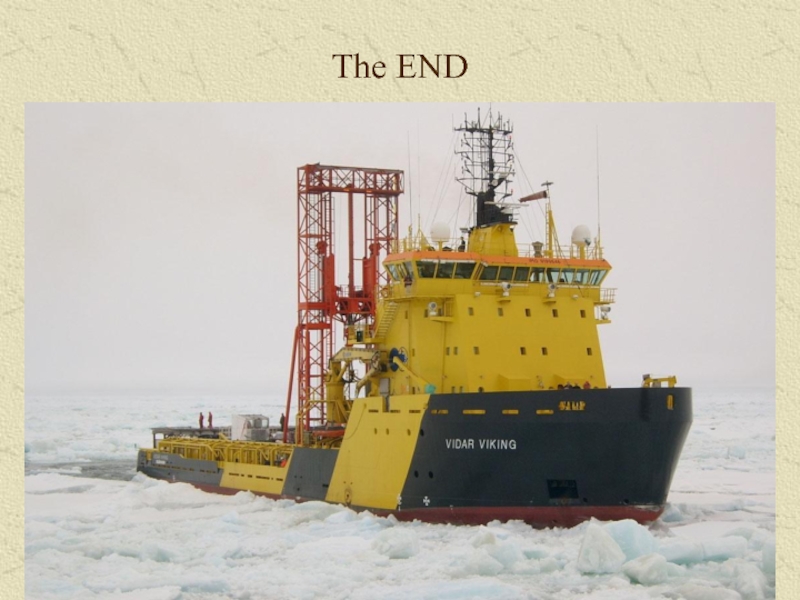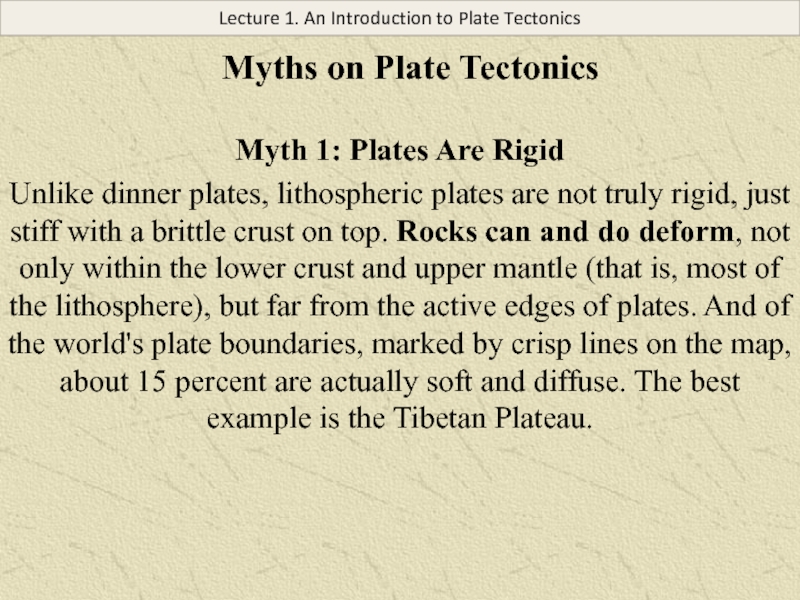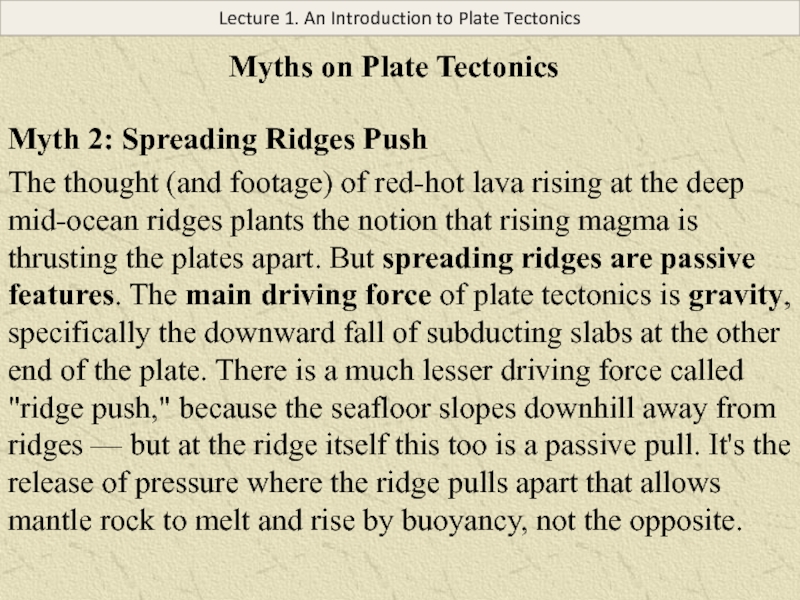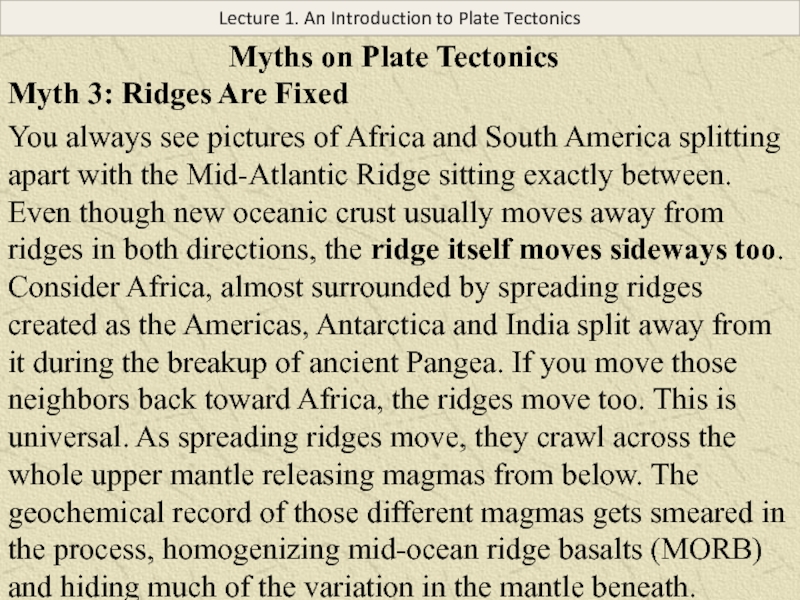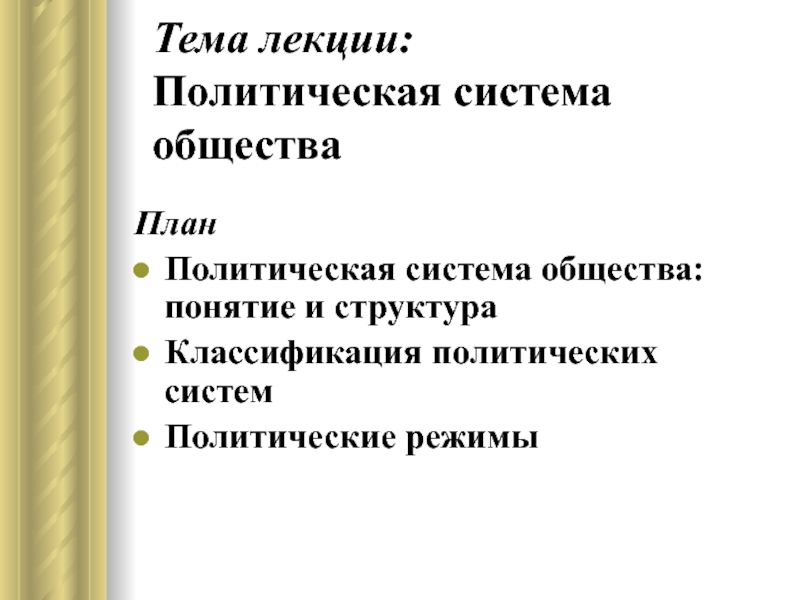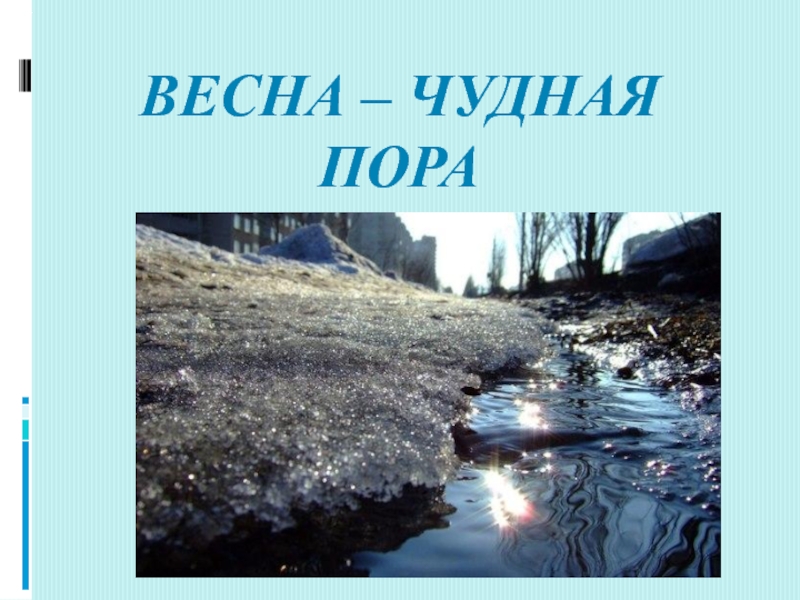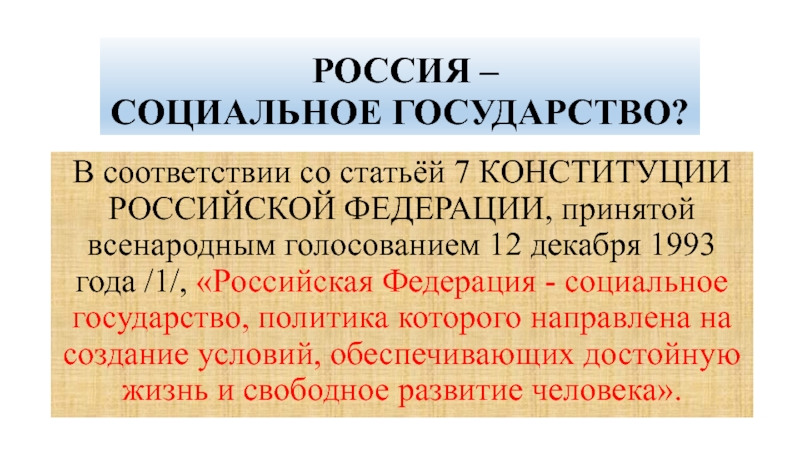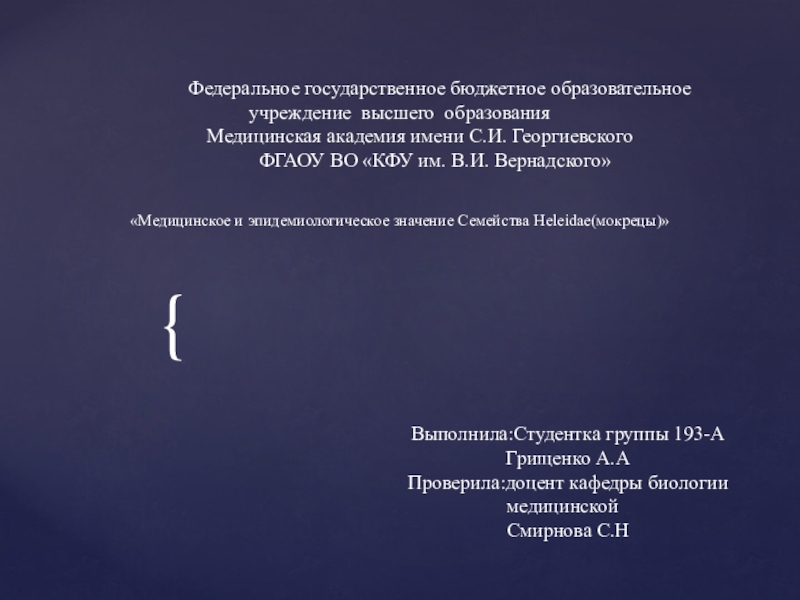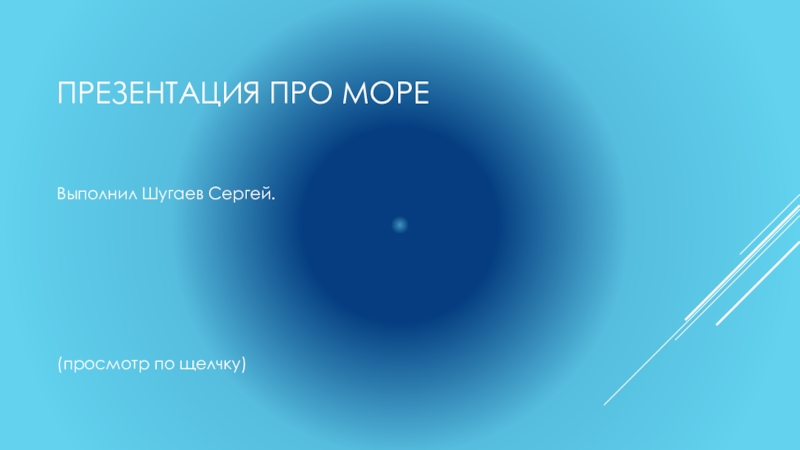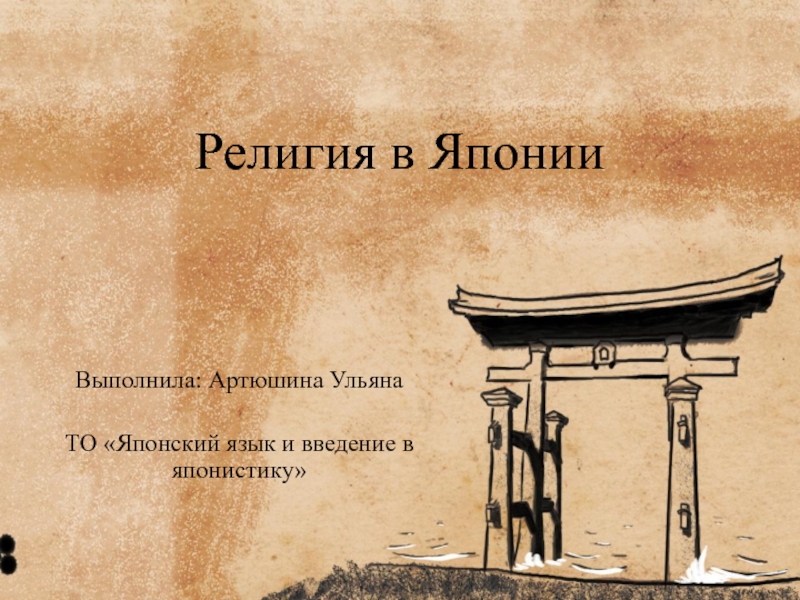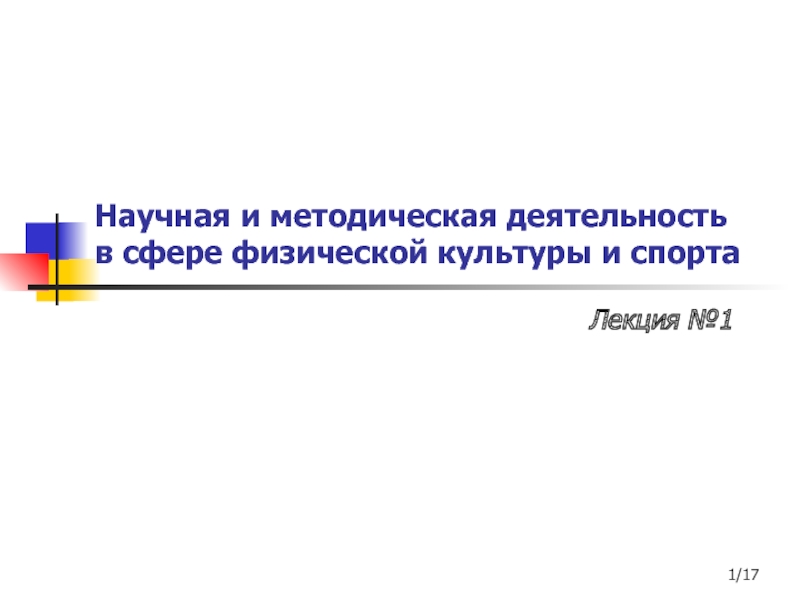Слайд 1Lection 1
Lithosphere & Astenosphere
An Introduction to Plate Tectonics
…a theory
should be as simple as possible, but no simpler.
Albert Einstein
Course: Particularities and Features of Cold Region Geology
by
Alexey A. Krylov,
Institute of Earth Sciences, St. Petersburg State University
Слайд 2Lecture 1. An Introduction to Plate Tectonics
Continental Drift, Sea-Floor Spreading,
and
Plate Tectonics
Since the construction of the first good maps
of the continents, people have puzzled over the close match between the coastlines of South America and Africa.
Слайд 3Lecture 1. An Introduction to Plate Tectonics
Alfred Wegener, a German
meteorologist, proposed the continental drift hypothesis (between 1919-1929) to explain:
-
the observed shape of the coastlines;
- the observation of fossils and rocks on opposite sides of the ocean etc.
Alfred Wegener
1880-1930
Continental Drift, Sea-Floor Spreading, and
Plate Tectonics
Слайд 4Lecture 1. An Introduction to Plate Tectonics
Continental Drift, Sea-Floor Spreading,
and
Plate Tectonics
How the seeds could have migrated across
the oceans unless the continents were connected by mysterious land bridges.
Seed fern fossil, called Glossopteris, is one of the many fossils that were found on both sides of the Atlantic Ocean.
Слайд 5Lecture 1. An Introduction to Plate Tectonics
Continental Drift, Sea-Floor Spreading,
and
Plate Tectonics
Wegener proposed that at one time, all the
present-day continents actually were combined into a "super-continent" which he called Pangaea (or Pangea).
Слайд 6Lecture 1. An Introduction to Plate Tectonics
Continental Drift, Sea-Floor Spreading,
and
Plate Tectonics
Alfred Wegener was unable to provide a reliable
mechanism that explains the continental drift.
PROBLEMS:
He supposed that the centrifugal force of the Earth's rotation or the astronomical precession caused the drift.
Simple calculations show that this is impossible.
The scientific community has rejected the hypothesis of Alfred Wegener.
Слайд 7C: Lehmann–Bullen discontinuity – the inner-outer core bound.
Lecture 1.
An Introduction to Plate Tectonics
Structure of the Earth
1. continental crust
2.
oceanic crust
3. upper mantle
4. lower mantle
5. outer core (liquid)
6. inner core (solid)
A: Mohorovičić discontinuity – the boundary between crust and mantle.
B: Gutenberg discontinuity – the core-mantle boundary.
Слайд 8Lecture 1. An Introduction to Plate Tectonics
Structure of the Earth
Слайд 9Lecture 1. An Introduction to Plate Tectonics
Two types of the
Earth Crust
Sedimentary layer
10
Upper crust:
“Granite layer” SIAL
20
Conrad boundary
Lower crust:
“Basalt layer” SIMA
“Moho”
boundary
Upper mantle
40
Basement’s surface
30
1
2
4
3
0
km
0
5
6
7
km
Sediments – Layer 1
Layer 2
2A(B) Basaltic pillow lava
2C Dolerite dikes
Layer 3
3A Isotropic gabbro
3B Serpentized peridotite
“Moho” boundary
Upper mantle
Layer 2: tholeiite (low-K olivine basalts)
Continental crust
Oceanic crust
Oceanic crust is mainly made of basalt whereas continental crust is mainly made of granite
The lower density of continental crust allows it to float on the mantle.
Слайд 10Lecture 1. An Introduction to Plate Tectonics
Two types of the
Earth Crust
Oceanic crust
Sediments
Serpentinized peridotites
Слайд 11Lecture 1. An Introduction to Plate Tectonics
Recently formed pillow lava
(basalt), off Hawaii
Oceanic crust
Слайд 12Lecture 1. An Introduction to Plate Tectonics
Oceanic crust
A dolerite is
the medium-grained equivalent of a basalt - a basic rock
dominated by plagioclase and pyroxene.
Diabase is often used as a synonym of dolerite by american geologists, however, in Europe the term is usually only applied to altered dolerites.
Слайд 13Lecture 1. An Introduction to Plate Tectonics
Oceanic crust
Gabbro from ocean
crust.
The gabbro is deformed because of intense faulting at
the eruption site.
Gabbro refers to a large group of dark, often coarse-grained, mafic intrusive igneous rocks chemically equivalent to plutonic basalt.
It forms when molten magma is trapped beneath the Earth’s surface and slowly cools into a holocrystalline mass.
Слайд 14Lecture 1. An Introduction to Plate Tectonics
Oceanic crust
Serpentinized peridotite
Peridotite is
classified as an ultramafic rock.
It has less than 45%
silica in its structure.
It is mostly made of the minerals olivine and pyroxene.
Слайд 15Lithosphere & Astenosphere
1300°С
Lecture 1. An Introduction to Plate Tectonics
Earth's
lithosphere = the crust + the uppermost mantle → constitute
the hard and rigid outer layer of the Earth.
The lithosphere is subdivided into tectonic plates.
Слайд 16Lithosphere & Astenosphere
Lecture 1. An Introduction to Plate Tectonics
Astenosphere
is
the highly viscous, mechanically weak and
ductilely-deforming region of the
upper mantle.
1300°С
At about 1300°C typical mantle material begins to melt, and softens dramatically. We call that part of the mantle asthenosphere. It is a weak zone, that "decouples" the plate from the overlying mantle.
Слайд 17Convection of Mantle
The asthenosphere is ductile and can be pushed
and deformed like silly putty («умный пластилин») in response to
the warmth of the Earth.
Lecture 1. An Introduction to Plate Tectonics
These rocks actually flow, moving in response to the stresses placed upon them by the churning motions («возвратно-поступательное движение») of the deep interior of the Earth.
The flowing asthenosphere carries the lithosphere of the Earth, including the continents, on its back.
Слайд 18Convection of Mantle
Lecture 1. An Introduction to Plate Tectonics
Ridge push
happens at spreading centers where plates are moving apart.
Slab
pull happens at subduction zones where one plate is pulled down into the mantle.
Сross section through the Earth showing the convection cells of the mantle.
Слайд 19Plate Motion
- Movements deep within the Earth →
- carry
heat from the hot interior to the cooler surface →
-
the plates to move very slowly on the surface, about 2 inches per year.
Subduction zones → plates crash into each other; spreading ridges → plates pull away from each other; large faults → plates slide past each other.
Lecture 1. An Introduction to Plate Tectonics
Слайд 20Plate Motion
There are many evidence that supports the theory of
plate tectonics: сontinental drift, earthquakes, volcanoes, magnetism, and heat flow
that cause seafloor elevation/spreading.
Lecture 1. An Introduction to Plate Tectonics
Слайд 21Divergent & Convergent boundaries
Lecture 1. An Introduction to Plate Tectonics
Слайд 22Divergent Plate boundaries.
1. Continent – Continent Rifting (Diverging)
Lecture 1. An
Introduction to Plate Tectonics
Слайд 23Divergent Plate boundaries.
2. Ocean – Ocean Divergence (Rifting).
Lecture 1. An
Introduction to Plate Tectonics
Слайд 24Convergent Plate boundaries.
1 stage. Conversion of oceanic crust to continental
crust.
Lecture 1. An Introduction to Plate Tectonics
Слайд 25Convergent Plate boundaries.
2 stage. Converging Plate Boundary - Continent
to Ocean
Lecture 1. An Introduction to Plate Tectonics
Слайд 26Convergent Plate boundaries.
3 stage. Converging - Continent to Continent
Lecture
1. An Introduction to Plate Tectonics
Слайд 27Lecture 1. An Introduction to Plate Tectonics
HEAT FLOW
The average continental
heat flow is about 57 milliwatts per square meters (mW/m^2),
the oceanic heat flow is about 100 mW/m^2. The "warm" colors yellow-orange-red indicate higher than average heat flow, the blues are lower. The heat flow is greatest along the system of mid-ocean ridges.
Слайд 28Plates of the Earth
Lecture 1. An Introduction to Plate Tectonics
Слайд 29Plates of the Earth: What Is A Plate?
Lecture 1. An
Introduction to Plate Tectonics
Plates are large pieces of the upper
few hundred kilometers of Earth (usually on the order of 100-200 km thick) that move more or less as a single unit.
It is easier to think of plates as rigid "rafts" floating on the mantle, but some plates also have some internal deformation. However, it is clear that the most active deformation of the plates occurs along their boundaries, where they interact with other plates.
Слайд 30Lecture 1. An Introduction to Plate Tectonics
Plates of the Earth
Primary
plates
These seven plates make up most of the seven continents
and the Pacific Ocean.
1) African Plate; 2) Antarctic Plate; 3) Eurasian Plate;
4) Indo-Australian Plate; 5) North American Plate; 6) Pacific Plate; 7) South American Plate
Слайд 31Plates of the Earth
Lecture 1. An Introduction to Plate Tectonics
Secondary
plates
Arabian Plate; Caribbean Plate; Cocos Plate; Juan de Fuca Plate;
Indian Plate; Nazca Plate; Philippine Sea Plate; Scotia Plate
Слайд 32Rate of Plate Movement
San Andreas Fault - 5.5 cm/yr
Mid-Atlantic
Ridge
Iceland - 1.8 cm/yr;
South
Atlantic (Ascension Island) - 3.9 cm/yr
East Pacific Rise - off South America
Most rapid movement - 17.1 cm/yr
Lecture 1. An Introduction to Plate Tectonics
Слайд 33Tectonic Rate Map
Lecture 1. An Introduction to Plate Tectonics
Слайд 34Hot Spots
A volcano hotspot is a region on the Earth’s
surface that has experienced volcanism for a long time. A
good example of this is the Hawaiian Islands. Each of the islands in the long chain were created by the same volcano hot spot.
Lecture 1. An Introduction to Plate Tectonics
The volcano built up an island that extended above the surface of the ocean, and then plate tectonics carried the island away, creating an extinct volcano. But there’s always a new volcano being created by the same hot spot.
Слайд 35Hot Spots
Lecture 1. An Introduction to Plate Tectonics
Much remains unknown
about the nature of hot spots.
Where they originate: upper
mantle/lower mantle/ core-mantle boundary?
Are they stationary or slowing drifting (but moving slower than the plates)?
The large number of hot spots in the Atlantic ocean are suspected to have played a role in the breakup of Pangaea.
Слайд 36Hot Spots
Lecture 1. An Introduction to Plate Tectonics
Слайд 37Magnetic Anomalies
Lecture 1. An Introduction to Plate Tectonics
The "geomagnetic" field
is generated by motions of the iron in the outer
core. One property of a moving conductor «электродинамический» (such as the flowing iron in the outer core) is that it produces a magnetic field.
That same magnetic field allows us to use a compass to navigate around Earth's surface.
Слайд 38Lecture 1. An Introduction to Plate Tectonics
Magnetic Anomalies
The Earth's magnetic
filed provides some valuable information on the location of rocks
when they form.
As the lava cools the iron they contain is preferentially oriented by the magnetic field of Earth, like mini-compasses.
As the rock continues to cool, its temperature decreases below the "blocking temperature" and the magnetically induced alignment of iron is frozen into the rock.
The net result is that the rock storing information on the orientation of Earth's magnetic field at the time the rock cooled.
Слайд 39Magnetic Anomalies
Magnetic reversal time scale over the past 70 million
years.
Black intervals had normal polarity (like that today),
and
white intervals had reversed polarity.
Lecture 1. An Introduction to Plate Tectonics
Слайд 40Magnetic Anomalies
Lecture 1. An Introduction to Plate Tectonics
Слайд 41Magnetic Anomalies
Normal (+) and reversed (-) magnetization of the seafloor
about the mid-ocean ridge.
Note the symmetry on either side
of the ridge.
Lecture 1. An Introduction to Plate Tectonics
Слайд 42Magnetic Anomalies
Lecture 1. An Introduction to Plate Tectonics
The youngest regions
are shown in red (age < 2 Ma) and red-orange
(age 2 Ma < 5 Ma), the older regions in orange, gold, yellow, green, blue, and violet.
It is clear from the Figure that the ocean ridges are the youngest part of the oceans.
Spreading is slower in the mid-Atlantic than along the east-Pacific.
Слайд 43Lecture 1. An Introduction to Plate Tectonics
Increasing the thickness of
lithosphere with time.
Слайд 44Magnetic Anomalies
Lecture 1. An Introduction to Plate Tectonics
Слайд 45Magnetic Anomalies
Lecture 1. An Introduction to Plate Tectonics
Слайд 46Magnetic Anomalies
Lecture 1. An Introduction to Plate Tectonics
Слайд 47Cycles of Plate Tectonics
Lecture 1. An Introduction to Plate Tectonics
Wilson
Cycle:
Rifting of continents by mantle diapirism
(2) Continental drift, seafloor
spreading & formation of ocean basins
(3) Progressive closure of ocean basins by subduction of ocean lithosphere
(4) Continental collision and final closure of ocean basin
Слайд 48Cycles of Plate Tectonics
Numerous cycles of breakup and collision have
preceded Wegener's Pangea
Late Precambrian - continents together in one
land-mass
Break apart during Cambrian and Ordovician, come back together Devonian through Permian - reassemble Pangea .
Form Appalachian Mtns.
Lecture 1. An Introduction to Plate Tectonics
Cycles of breakup and collision have influence on biological evolution
Breakup/rifting - continents separate
Milder climate, separation of forms - genetic drift. Diversity of species
Collisions - continents reassembled
More extreme climate - land masses together
Species brought together - competition
Continents reassembled - times of extinction
Слайд 49Cycles of Plate Tectonics
Lecture 1. An Introduction to Plate Tectonics
GONDWANA, ancient
supercontinent that incorporated present-day South America, Africa, Arabia, Madagascar, India,
Australia, and Antarctica.
PANGEA, a “supercontinent” that incorporated almost all of Earth’s landmasses and covered nearly one-third of Earth’s surface.
LAURASIA, ancient continental mass in the Northern Hemisphere that included North America, Europe, and Asia (except peninsular India).
Слайд 50Lecture 1. An Introduction to Plate Tectonics
UNDEFORMED MARINE SEDIMENTS
Horizontal layering
Conformably
of layering
Permanent thickness of sediment layers
Слайд 51DEFORMATION
Deformation-
Modification of Rocks by Folding and Fracturing
Lecture 1. An Introduction
to Plate Tectonics
Слайд 52FAULTS
Lecture 1. An Introduction to Plate Tectonics
Слайд 53CONTINENTAL SLOPE
Lecture 1. An Introduction to Plate Tectonics
A passive margin
is the transition between oceanic and continental crust which is
not an active plate margin.
While a weld («шов») between oceanic and continental crusts are called a passive margin, it is not an inactive margin. Active subsidence, sedimentation, growth faulting, pore fluid formation and migration are all very active processes on passive margins.
Слайд 54CONTINENTAL SLOPE
Passive margin
Lecture 1. An Introduction to Plate Tectonics
Слайд 55CONTINENTAL SLOPE
Passive margin
Lecture 1. An Introduction to Plate Tectonics
Слайд 56CONTINENTAL SLOPE
Active margin
Lecture 1. An Introduction to Plate Tectonics
Active continental
margins, i.e., when an oceanic plate subducts beneath a continent,
represent about two third of the modern convergent margins.
Слайд 58Lecture 1. An Introduction to Plate Tectonics
Myths on Plate Tectonics
Myth 1: Plates Are Rigid
Unlike dinner plates, lithospheric plates are
not truly rigid, just stiff with a brittle crust on top. Rocks can and do deform, not only within the lower crust and upper mantle (that is, most of the lithosphere), but far from the active edges of plates. And of the world's plate boundaries, marked by crisp lines on the map, about 15 percent are actually soft and diffuse. The best example is the Tibetan Plateau.
Слайд 59Myth 2: Spreading Ridges Push
The thought (and footage) of red-hot
lava rising at the deep mid-ocean ridges plants the notion
that rising magma is thrusting the plates apart. But spreading ridges are passive features. The main driving force of plate tectonics is gravity, specifically the downward fall of subducting slabs at the other end of the plate. There is a much lesser driving force called "ridge push," because the seafloor slopes downhill away from ridges — but at the ridge itself this too is a passive pull. It's the release of pressure where the ridge pulls apart that allows mantle rock to melt and rise by buoyancy, not the opposite.
Lecture 1. An Introduction to Plate Tectonics
Myths on Plate Tectonics
Слайд 60Myth 3: Ridges Are Fixed
You always see pictures of Africa
and South America splitting apart with the Mid-Atlantic Ridge sitting
exactly between. Even though new oceanic crust usually moves away from ridges in both directions, the ridge itself moves sideways too. Consider Africa, almost surrounded by spreading ridges created as the Americas, Antarctica and India split away from it during the breakup of ancient Pangea. If you move those neighbors back toward Africa, the ridges move too. This is universal. As spreading ridges move, they crawl across the whole upper mantle releasing magmas from below. The geochemical record of those different magmas gets smeared in the process, homogenizing mid-ocean ridge basalts (MORB) and hiding much of the variation in the mantle beneath.
Lecture 1. An Introduction to Plate Tectonics
Myths on Plate Tectonics
